Let’s talk...
About the sense of capability as children mimic the movements of various animals. We can talk to our child about tasks they can now accomplish that they couldn’t before. We can also boost their sense of capability by saying, “Yes, you can!”
About play: The book is interactive and encourages movement and play. We can talk with our child about the games they enjoy and introduce them to games we used to enjoy in our childhood.
Let’s enrich our Language...
The book is rich with action verbs and body part names like arms, legs, feet, neck, etc. We can facilitate their use in our daily lives to describe body parts and movements, encouraging the child to describe their actions.
Let’s explore...
We can explore different sources for information about the animals mentioned in the book: their types, food, and living habits. Also, we can enjoy watching a documentary with our child.
Let’s create...
The book employs the well-known collage technique of the illustrator Eric Carle, creating a beautiful composition of cutouts, fabrics, newspapers, and household materials.
Let’s play...
We can play the “Animal Yoga” game together, mimicking the movements of the various animals mentioned in the book, and adding other animals!
Let’s talk...
About feelings:
we can recall Sugar’s feelings in different situations, and we can ask our child: How did she feel? How did she manage to get the apples and who helped her?
About disagreements: Sugar disagreed with her friend Mina over an apple. We can suggest another ending to their disagreement.We can ask our child: Have you ever disagreed with your friend? How did you overcome it?
About similar situations: Have you ever faced a difficulty? How did you handle it?
About situations: How should we interact with people with special needs?
Let’s enrich our language...
We can look for new expressions in the book and explain them to the child, such as: landed on the ground, the sun was about to set, well-fed, swaying, and others.
Let's communicate...
Words of encouragement: The bird helped Sugar and encouraged her saying: “Don’tworry Sugar, we will find another way. ”We can think with our children about phrases and expressions that can encourage us during difficulties, such as: “You can do it,” “Ibelieve in you,” “What matters is that you keep trying.”
What am I good at? We can draw our child’s hand on paper and think together about characteristics that make them special and skills they are good at, and record them in the hand drawing.
Let's share...
We can prepare food together using apples, such as: cake, pie, juice, or cut up an apple and enjoy eating it together.
Let's practice...
We can train our kangaroo jumps; we can try jumping on one leg, then on both legs, forward,backward, and so on.
Let's research...
We can learn about the kangaroo: What are its characteristics? Where does it live? What does it eat? We might want to draw it and design a pouch for it from paper or fabric.
Let’s talk...
About feelings: We can track different situations that happened with Mina: How did she feel? And how would you feel if you were in her place?
About similar experiences: We can ask our child: Have you faced difficulty in learning? How did you overcome it? And did you try to ask for help?
About our superpower: We can talk with our child about their unique abilities and characteristics.We can write them down and encourage them to ask siblings, relatives,and friends about the special qualities and abilities they see in them.
Let’s enrich our language...
Let’s clarify new words and expressions: extraordinary, somersault, shake, guessed, and others.
Let’s create...
We can choose a new word together from the story and discover different ways to learn it.We can sing it, draw it, and act it out.
Let’s explore...
In our Arabic language, both colloquial and classical, there are many names for objects, creatures, or places that begin with the word “Um” (mother), such as Um Arba’a wa Arba’een(Ladybug), Um Al-Qura (mother of villages-Mecca). We can explore other names
Let’s talk...
About the child’s opinion:
Mr. Round and Mr. Square see things in contrasting ways. We can ask our child: Are things really contradictory? How do you see it? Do you think the dog is first or last? Is the car really moving away or coming closer? We can encourage them to use expressions like “it depends on” or “according to,” to stimulate seeing things from multiple angles.
Similar experiences: we can ask our child: Have you ever disagreed with a friend?What was that like?
Let's stimulate thinking...
We can look at household items and describe them from Mr. Round’s and Mr. Square’s perspectives, for example: I see a wall behind the TV, or a TV in front of the wall. Let’s describe other items using different expressions like: in front-behind, above-below, or any other appropriate expression.
Let’s enrich our language...
The story is full of opposites, such as: near-far, first-last, bright-dark, and others. We can find them and use them to describe what’s around us.
Let’s create...
We can draw several circles on one paper and several squares on another, then create shapes and drawings from each circle and square.
Let's play...
We can compete to collect the largest number of items in our house that contain different shapes: circle, square, dots, parallel lines, and others.
Let’s talk...
About pirates and captains: We can ask our child: Is Salman a captain or a pirate? What’s the difference between them? Can he be both?
About flexible thinking: We can ask our child: Have you ever understood something in two different ways? Or have others interpreted it differently?
About similar experiences: We can askour child: Have you ever gone on a journey or had an adventure where you discovered something new? Where and what did you discover?
Let’s enrich our language...
We can learn new words like: mast, cabin, dozen, gang, amber, and others. We canlook for rhyming words in the text like: qursan (pirate), qubtan (captain), qumsan(shirts), sa’dan (monkey), farman (decree) and others.
We can try to understand their meanings and search for new words with the same rhythm.
Let’s create...
We can dress up as pirates, draw a treasure map, and go “pirating” together on an exciting search journey around and inside the house!
Let’s explore...
Characters: We can search for stories about famous maritime figures mentioned in the text, like Magellan, and others not mentioned, like Ibn Battuta, Khair ad-Din Barbous,and Sinbad. We can learn about researcher Jane Goodall and the fictional character Tarzan.
The Map: We can examine the map below and follow Pirate Salman’s ship route and explore the cities he visited: Who are their inhabitants? What is their traditional dress and folk food?
Let’s talk...
About different feelings: we can ask the child: Where is grandmother? Is she really present? How does the child in the story feel? What did she do to deal with her longing? Could there be other feelings the child has that aren’t shown in the story?
About similar experiences:we can ask the child: Have you ever lost someone or something dear to you? Do you miss them? What can you do when you’re missing them? In case of losing a grandfather or grandmother-let’s share beautiful memories together: what did we love to do together?
Let's observe...
The illustrations take us to the beautiful world that united the granddaughter and grandmother. Let’s examine the drawings and notice the items that passed from grandmother to granddaughter, and other items similar to what we see in our grandparents’ homes.
Let's communicate...
We can visit our grandmother or grandfather, tell them how much we love them, and together create an album or box of photos and items of beautiful memories with our grandparents.We can go to the sea together and collect different shells and stones.
Let’s explore...
We can think about the illustrations and try to guess which city grandmother’s house is in. We can recall other coastal cities in our country and learn about them.
Let’s talk...
About dealing with differences: We can ask our child: How was Cookie different from her friends? How did she feel? How did she find a solution to her problem?
About dealing with problems: We can our child if they ever felt different or faced a problem because of that difference. What did they do? How did they act? Did anyone support them? How did they do it?
Let’s create...
We can make a shell from household items and embark on different adventures from our imagination, narrating them with our words and movements.
We can ask our child to think of different ways to use various objects-spoon, piece ofcloth, book, pen, shells, and others…
Let’s explore...
We can visit the beach, search for living creatures on the shore, such as: turtles, crabs, seaweed, shells, and others. We can collect shells to make a necklace or picture frame.
Let’s communicate...
Our society includes different people, some of whom face various challenges like visual impairment and limited mobility. We can take our child on a tour around town and look for signs indicating accessibility for people with special needs. We can take pictures of them with our phone camera and talk about them and the importance of accessibility in general.
Let’s talk...
About situations and feelings: we can ask our child: Why was the frog running away?How was he feeling? What was he thinking? What helped him? What did he need to stop running?
About experiences and new places: we can ask our child: Have you ever been somewhere new? How did you feel? How did you act? What helps you overcome anxiety and face challenges?
Let's explore and enjoy...
The illustrator used collage technique in the story’s illustrations. Let’s examine the drawing sand try to spot other creatures hiding in the picture. Let’s search for them and name them.
Let's research and explore...
Two types of frogs were mentioned in the story: marsh frogs and tree frogs. What’s the difference between them? What are the characteristics of each?
Let’s explore the different stages of frog development.
We can also visit the forest, valley, or nearby public park to observe different living creatures and try to imitate their sounds.
Let's play together...
Let’s practice our frog jumps, imagining our house floor is the marsh, then build a path using pillows and rugs as stations, moving between them as frogs do in the marsh.
Let’s talk...
About problem solving: The siblings in the story faced a problem. We can ask our child: What was the problem? Who was able to solve it? Let’s share a problem we faced with each other and how we managed to solve it.
About sense of capability and promoting responsibility: We allow our child to choose a task in the house that they are responsible for implementing, and we can encourage them to do so.
About our child’s qualities: We can print our child’s hand on a paper, and write inside each finger our child’s qualities, characteristics, and strengths, then hang it on the refrigerator to give them a feeling of confidence and pride in their abilities
Let’s enrich our language...
We can examine the different drawings in the story: We can describe the drawings underground and above-ground and distinguish the similarities and differences between them. We can use terms like: wide, narrow, bright, dark, and others.
Let’s create...
Puppet: We can use old socks to make a puppet in the shape of Maurice the Mole. We can attach a nose and eyes to it, and dress it with a cloth hat. We can make whatever puppets we want for different animals.
Joint drawing:
We can draw a vertical or horizontal line on a paper and complete it each time in a different way. We can take turns with our child, to get a drawing, and we can colour the spaces in it together.
Let’s communicate...
We can have a meditation session and communication with nature. We can visit a nearby forest or garden and sit quietly and peacefully. We can also observe the different animals around us, smell the scents, and feel the wind blowing on our body.
Let's research...
We can search for animals that build their burrows underground, like the mole and others, and gather information about their characteristics and food. We can also watch a video about them on YouTube.
Let’s talk...
About the plot: The cat’s names varied in the story. We can follow the events of the story and the cat’s visits to different neighbours, and pay attention to its different names. We can ask our child: Why, in your opinion, did the cat stay in the elderly lady’s house? What did it find there? How did it help her deal with loneliness?
About feelings: We can browse the story with our child and talk about the feelings of the neighbours and the cat. How did they change in the story? And what caused that?
About social relationships: We can ask our child: What changed in the cat’s neighbourhood? How was the relationship between neighbours at the beginning of the story and at the end? We can share with our child things we do with neighbours and relatives on different occasions, such as: eating together, and going on trips.
What activity can we do with the participation of neighbours to enhance the good relationship with them?
Let’s communicate...
With Grandparents: We can spend enjoyable time with grandparents, ask about them and check on them, and maybe share the story with them and ask them: What do you need?
With neighbours: We can initiate an activity with neighbours, such as eating together,or cleaning the neighbourhoodand planting flowers.
We take care of neighbourhood cats: We can provide them with water and food in containers that we can make from used cans.
Let's create...
We can examine the drawings and try to discover the characteristics of each family in the neighbourhood, give them different names, and get to know their diverse cultures as evidenced by their clothes. We can also search for information related to those cultures.
Let's research...
We can search in our home library for stories about cats, such as the story “The Cat Zarif and his Magic Glasses” from the Lantern Library, and others.
Let’s talk...
We can develop our child’s imagination by creating an alternate ending for the story or continuing it ourselves. We can ask the child: What do you think happened to the anteater? Did he like the taste of bananas? Does he really eat bananas? Where did the ants disappear to? What do you think happened next?
Let’s communicate...
We can hold a family joke party. Each family member is invited to share their favourite joke, appropriate for the child’s age.
Let’s discover...
We can search for information about the types of animals mentioned in the story. Where does each animal live? What does it really eat? What is its preferred environment?
Let’s create...
We can encourage our child to create a painting using different colour combinations.We can use crayons and watercolours to colour on paper.
We can inspire our child to write their first humorous book or their unique version of “What Does the Anteater Eat?” Children can introduce new animals and craft a new creative ending to the story.
Let’s observe...
Ants walk along the bottom of most pages of the book, while the anteater walks through the forest landscapes searching for breakfast under his feet. We can follow the drawings, search for the ants, and remember to laugh along the way!
Let’s talk...
About anxiety: What happened to the little owl when her mother left her? How did she feel? How did the owl overcome her anxiety about her mother’s absence? What helped her?
Let’s communicate...
When we leave our child with others, it’s important for us to communicate and align expectations with the child and the adult responsible for them during our absence. We can create a schedule together and use symbols for our return time. For example: I’ll be back “after lunch” or “at sunset.”
What are our bedtime rituals at home? Let’s create a visual sleep routine chart together. We can add pictures and drawings; for example: a warm bath, gentle massage, bedtime story, and a goodnight kiss.
Let’s create...
Let’s make our own special night lamp that lights up exactly as we like. We can use cardboard or a small glass jar to decorate, adding a small light inside for a cozy glow.
Let’s talk...
About Friendship: We can ask our child: What does the word friend mean? How do we become friends? Who is your friend? And why are you friends? What do you like to do with them? What are the things you are similar in, and what are the things you differ in? What distinguishes your friend? And what is the thing you love most about your friendship?
We can also share with our children and tell them about our experiences with childhood friends.
Let’s enrich our Language...
We follow the movement of the yellow and blue spots in the drawings: When do they get closer? When do they move away? When do they blend? When do they grow and when do they shrink? We ask our child for their opinion on this.
We pay attention to the opposites in the story’s vocabulary.
Let's communicate...
We can invite our friends for a nice visit to our home and spend an enjoyable time together.
Let’s create...
The artists used the printing technique. We can dip half a potato, or a flat eraser, or a piece of sponge in “gouache” paint and make a stamp. We can print shapes of different colours on paper, and we may complete their small details with the help of a pen.
Let’s talk...
About desires and feelings: The girl wanted a shiny bag decorated with planets, but she got another bag which made her angry. We can follow the angry child’s behavior in the story, and ask our child: How did the child express her anger? How did she behave with her classmates? How did her feelings change? Was the bag really terrible? How did her view of it change?
About similar experiences: We can talk to our child about experiences similar to the story. We can ask them: Has it happened that you strongly desired something, like the child in the story, and got something else? How did you feel? How did you behave?
Let’s enrich our language...
The story is rich with words and terms from the world of space, such as: planet, star, galaxy, space dust, Halley’s comet, spaceship, and many other terms. Let’s search for them in the story together.
Let's imagine...
The cardboard box became a spaceship; let’s imagine and complete the following sentence: This is not a box but it could be…..
Let’s create...
We can recycle some cardboard and shoe boxes at home, and make new toys such as: a spaceship, doll houses, a jewellery box, a car and others.
Let's research...
We can visit a museum that displays information about space, or watch a family movie about space.
Let’s talk...
What makes us grumpy? We can clarify with synonyms like dissatisfied, upset, resentful, irritated, sad, sulky, or in a bad mood.
How does my body feel when I’m grumpy? What about my facial expressions?We can share our experiences with our children and encourage them to share theirs.
What are things that help me calm down? For example: waiting a little, hugging, playing, talking to a friend, drawing, etc.
Let's research...
Let’s examine the illustrations to find clues about the bird’s feelings. We can observe how different colours express emotions.
Let's communicate...
We can play “Imitate My Move:” Each time the child makes a move, family members copy the child’s movements, adding new ones and taking turns.
Encouraging helping others: We can motivate our children to offer assistance, using phrases like “Do you want help?” or “Can I help?” We can also encourage them to take care of neighbourhood animals by providing water or food.
Let's discover...
We can observe birds in our garden or neighbourhood and research their names.
نتحاور
نتحاوَر حول:
المَشاعر: نتحدّث عن مَشاعر الفيل في مشكلته، وفي المَواقف المختلفة، ونلاحظها بعد مساعدة القرد له. نتحدّث عن مشاعر الحيوانات التي أربكَها سلوك الفيل. نتحدّث عن مشاعرنا المتوتّرة أو الغاضبة وسبُل التعامل معها دون تخريب.
ردود الأفعال: نلاحظ سلوك الفيل، وردود أفعال الشخصيّات. ننتبه لاستجابة الفيل لمساعدة القرد، وكيف ساهمت في حلّ المشكلة. نربطها بمواقف من حياتنا وخبراتنا الشخصيّة. كيف نعبّر عن مشاعرنا المؤلمة في الأزمات؟ كيف نساعد شخصًا في أزمةٍ أو ضائقة؟
الأزمات: ضائقة/ مشكلة/ أزمة- ماذا نعني بها؟ هل مررنا بمواقف مشابهة؟ نصفها ونستذكر مشاعرنا فيها. مَن ساعدَنا وكيف؟ هل ساعدنا شخصًا في أزمة أو مشكلة؟
خطوات مساندة: “أهدأ/ قف أرجوك أنا هنا لأساعدك”. هكذا منَح القرد الفيلَ أمانًا ليساعده في الحلّ. نتحدّث عن الخطوات التي تساعدنا في مواقف مربكة. قد نتنفّس ببطء/ نطلب المساعدة/ نجلس في ركنٍ هادئ/ نعبّر عن شعورنا ونسمّيه. ماذا أيضًا؟
البيئة: شكّل الكيس خطرًا على الفيل. نتحدّث عن مساهمتنا في المحافظة على البيئة والأحياء.
نُثري لغتنا
المفردات: نقرأ النصّ ونوضح معاني المفردات. نتعرّف على تسمية المشاعر المختلفة وكيفيّة التعبير عنها.
الأفعال:
نميّز الأفعال الحركيّة: ركض/ اندفع/ هزّ/ طارت/ تقدّم/ داس/ قفز.. نؤدّيها حركيًّا ونلاحظ أثرها. نقترح أفعالًا حركيّةً أخرى ونلاحظ الفرق بينها.
نميّز الأفعال الكلاميّة: صرخ/ تجادل/ تناقش/ تساءل.. نلاحظ الفرق بينها ونقترح ما يلائمنا للتعبير.
نميّز الأفعال الشعوريّة: شعر بالاختناق/ خاف/ ضايق/ غضب. نتحدّث عن المشاعر وإشاراتها في الجسد وتعابيرها في ملامحنا، وطرق التعبير عنها.
الصّفات: نلاحظ صفات فيلون في النصّ، مَن يشبه ممّن نعرف؟ نقارن بين لطفه مع أصدقائه وسلوكه مع المشكلة. نلاحظ صفات القرد وبقية الحيوانات. ماذا نستنتج عن كلّ منها؟
أسماء التحبّب: فيلون صيغة تصغير للفيل. ما هي الصّيَغ التي يحبّها أطفالنا لمناداتهم؟ نلاحظ الصيغ الصرفية الممكنة. قد نضيف للاسم مقطعًا أو نغيّر وزنه.
نلعب
ماذا في الصّورة: نجمع مجموعة صوَرٍ لمواقف حياتيّة، نتمعّن ونتعرّف على المشكلة فيها، ونقترح حلولًا ملائمة. (مثلًا: طفلٌ يبكي/ طفلان يتشاجران على لعبة/ طفلٌ سقط عن الزلاجة).
مَن أنا؟: تتّفق المربّية مع أحد الأطفال على أداء شخصيّة حيوانٍ ما. يقلّد الطفل الحيوان، ويكون على بقيّة الأطفال أن يعرفوه. نوجّه الأطفال إلى التعبير عن الحيوان بالجسد، ثمّ بالحركة، ثمّ بالصّوت.
نستكشف
نستكشف:
الغابة والحيوانات: في النصّ كثيرٌ من محتويات الغابة، ومختلف مواقعها وسكّانها. نبحث عن صوَرٍ ومعلوماتٍ عنها في الموسوعات والمَواقع. نستمتع بالتعرّف عليها وعلى بيئاتها وظروف معيشتها. قد نعدّ موسوعةً خاصّةً نضيفها إلى مكتبتنا، وقد نستعين بها لإنتاج غابتنا في ركن البناء.
نبدع
في بستاننا مسرح: نؤدّي مَشاهد من القصّة. كيف تتحرّك الشخصيّة؟ نلاحظ نبرة صوتها وطريقة تعبيرها. كيف يتحرّك الفيل والكيس في خرطومه؟ كيف تتساءل الزرافة عن حلّ؟ إلخ.
بستاننا أخضر: تسبّب الكيس بمشكلةٍ لفيلون. ماذا يقترح أطفالنا لاستحداث موادّ ومهملات بدلًا من رَميها؟ هل نقيم ورشةً للاستحداث ونُعيد إنتاج الموادّ بطرقٍ إبداعيّة؟ قد ننتج أيضًا مجسّماتٍ للحيوانات من الموادّ المستحدثة.
صندوق الأدوات للأزمات: نخصّص ركنًا صغيرًا في البستان، ونعدّ فيه صندوقًا لمساعدتنا في المواقف المزعجة. نفكّر معًا في أمورٍ من شأنها مساعدتنا في الأزمات، قد تكون جملةً نكرّرها عند الضيق :”أنا منزعج / غاضب/ مرتبك، لكن سأحاول أن أهدأ”. أو مقولةً داعمةً منّا نساند بها بعضنا، مثل: “أنا أحبّك/ أنا معك/ لا تقلق سأساعدك/ تعال نفكّر معًا”. نصغي إلى اقتراحات الأطفال ونضيفها في صندوق أدواتنا، ليلجأ إليها الأطفال عند الحاجة. (مثل: قراءة قصّة/ سماع موسيقى هادئة/ تأمّل صورة لمنظر طبيعيّ).
نتواصل
نتواصل:
نحافظ على البيئة: نفكّر معًا في طرق حماية البيئة والمحافظة عليها. قد نقترح مبادرةً لتنظيف مدخل البستان، أو تزيين البيئة بالنباتات. قد ندعو الأهل والأجداد لمشاركتنا في ورشةٍ خاصّة.
نساند بعضنا: نستضيف أخصّائيًّا في لقاءٍ مع الأهل، ونكتسب طرقًا وآليّاتٍ جديدةً للتعبير عن مشاعرنا، ولمدّ يد العون لمَن هم في ضائقة. قد نبادر أيضًا لمشروعٍ خيريٍّ لدعم المحتاجين في بلدتنا.
نتحاور
نتحاوَر حول…
المَشاعر: نتحدّث عن مَشاعر الفيل في المَواقف المختلفة. نستكشف مشاعر الحيوانات التي أربكَها سلوك الفيل، ونتحادث عن مشاعرنا المتوتّرة أو الغاضبة وسبُل التعامل معها دون تخريب.
ردود الأفعال: نلاحظ سلوك الفيل، وردود أفعال الشخصيّات. ننتبه لاستجابة الفيل لمساعدة القرد، وكيف ساهمت في حلّ المشكلة، ونربطها بمواقف من حياتنا العائليّة.
ضائقة/ مشكلة/ أزمة- ماذا نعني به، وهل مررنا بها؟ نصفها ونستذكر مشاعرنا فيها: مَن ساعدَنا وكيف؟ هل ساعدْنا شخصًا في مشكلة؟
خطوات مساندة: “اهدأ أرجوك، أنا هنا لأساعدك”، طمأن القرد الفيل. نتحدّث عن الخطوات التي تساعدنا في مواقف ضاغطة.
البيئة: شكّل الكيس خطرًا على الفيل. نتحدّث عن مساهمتنا في المحافظة على البيئة والأحياء.
نثري لغتنا
نُثري لغتنا
نقرأ النصّ ونوضح معاني المفردات. نتعرّف على تسمية المشاعر المختلفة وكيفيّة التعبير عنها. نتعرّف على الأفعال في النصّ، معانيها، أصواتها وحروفها. نلاحظها مع المذكّر والمؤنّث.
نتعرّف على الصّفات: نلاحظ صفات فيلون في النصّ، مَن يشبه ممّن نعرف؟ ما هي صفات كلّ فردٍ في عائلتنا؟
نبدع
نبدع
الصّندوق السحريّ: نفكّر معًا في أمورٍ من شأنها مساعدة الطفل في الأزمات، قد تكون مقولةً منّا مثل :”أنا معك وتعال نفكّر معًا”، أو غرضًا يحبّه، أو صورةً لعناقٍ يجمع عائلتنا. قد نضيف جملًا مطمئنة، مثل: “أنا أحبّك” أو جملًا يكرّرها الطفل لنفسه: “أنا منزعج /غاضب، لكن سأحاول أن أهدأ”، أو صورةً لمكانٍ طبيعيّ/ لشخصٍ يتنفّس بهدوء.
نجمع الأدوات في صندوقٍ، نزيّنه ونجهّزه للمَواقف المربكة. قد نتّفق أيضًا على ركن صغيرٍ في بيتنا يلجأ إليه الطفل عند الحاجة، نضع فيه الصّندوق، ليكون مخصَّصًا لتخفيف التوتّر وإعلان طلب المساعدة.
Let's talk...
About pet care at home: Why is it important for the child? Who takes care of it, and how?
About the feelings of the child in different situations before and after Zaatar’s disappearance. What do her drawings tell us about her feelings?
About asking for help: When and whom do we turn to for help? Let’s remember situations where we supported our child.
About friendship: Zaatar is Dan’s friend. Who are our friends and what do we like to do with them?
Let’s enrich our Language...
We can suggest suitable names for a pet we want to raise. Why did we choose these names?
We can imitate the sounds of animals we know and learn their names like the meow of the cat and the bark of the dog, among others.
Let's play and have fun...
We can enjoy playing group games with our child, such as Blind Man’s Bluff, and the “Hot and Cold” game.
Treasure hunt: We can hide an object in one of the places in the house and give our child clues about the location, for example: there are plates and spoons there. We develop the child’s ability to describe by suggesting the use of different words, such as: above, inside, and describing objects and places. We then switch roles.
Let’s have fun together with role-playing games, such as: I’m the customer and you’re the seller, or the father and the child, and others.
Let's create...
We can prepare a comfortable and warm place for the household pet or neighborhood cats with our child.
We can allocate a place with our child to feed the neighbourhood cats. What food do we provide? Who do we share with from the neighbourhood?
Let's explore...
We can search for information about animals we want to learn about, and we can also spend an enjoyable day visiting the zoo.
Let's talk...
About characters in the story: We can compare the traits of the merchant, the tiger, the bull, and the rabbit. We can deduce what distinguishes them through their behaviour.
About the concept of justice and fairness: Does doing good always bring good in return? We might initially think that the good deed the merchant did for the tiger would lead to a disaster, but the cleverness of the rabbit shows us a different outcome. What can we conclude?
About the trust: A simple word that can be expressed through feelings, thoughts, and actions. We can recall people we trust deeply. How did that trust develop?
About experiences from our lives: Have we done a good deed and offered help to someone? We can recall experiences from our lives where we received help or provided it.
Let’s enrich our Language...
New words and vocabulary: We can familiarize ourselves with unfamiliar words and understand their meanings.
Punctuation marks: We can observe question/exclamation/quotation marks. What do they mean?
Proverbs and sayings: We can search for proverbs, sayings, and admonitions that talk about doing good, justice, caution, and other meanings that captivate us.
Let's create...
Role-playing: Each of us plays the role of one of the story’s characters. We can think about their situation, feelings, and expressions.
Courtroom game: We can choose situations from our daily lives, and each of us can play a role in defending a different position. Who among us is the judge/accused/lawyer? Who supports another character?
Let's explore...
Nature: We can go on a hike to the nearby nature. Which trees do we notice? What animals might we encounter? We capture natural scenes and compile them as a memory of our enjoyable outing together.
Animals around us: Are there any pets in our neighborhood looking for shelter or food? How can we help them safely? (We might prepare a box for cat food or a bird feeder).
Let’s talk...
About our child’s desires and dreams: We can talk about them, reflect on whether they are achievable, and explore how to turn desires into goals and what helps us achieve them.
About problem-solving: What challenges have we faced, and how have we successfully invented solutions? We can recall our child’s successful experiences.
About natural phenomena: We can observe a natural phenomenon, listen to our child’s explanation, and explore its scientific reality together, such as falling leaves, sunset, and sunrise, cloud formation, and rain.
About gifts: What gifts does our child wish to receive? What surprise gifts have delighted them?
About our shared experiences: What activities does our child want to participate in together? We can brainstorm ideas for an enjoyable and meaningful time together.
Let’s enrich our Language...
The moon: We can learn the basic phases of the moon (crescent, full, new). We familiarize ourselves with the concept of lunar months.
Nisan: It is one of the months in the Gregorian calendar (solar). We can recall the months and observe the characteristics of each of them.
Meanings of words: We can clarify new words and explain their meanings (gap, dim, stillness). We can think with our child about words that sound or mean something similar.
Let’s explore...
Light and shadow: We can choose a room for a nighttime game, turn off the lights, and use lamps to explore the images we can create by reflecting our shadows on the wall. We can invent shapes and movements and enjoy their shadows.
Moon phases: We can observe the moon for several days. We may photograph or draw it and compare its different phases. We may seek information from scientific sources.
Let’s create...
Enjoy songs and poems about the moon. We can perform expressive movements, dancing together to their tunes.
Prepare a moon-themed board: We can add shiny crescent-shaped strips to a black cardboard every day until it completes the full moon shape.
Let’s talk...
About plot: We can observe the details of the illustrations, and encourage our child to describe them, follow the events, and make connections. We notice changes in the sea scene, the girl, and the birds, describing the girl’s feelings each time.
About personal experiences: Have we experienced similar feelings? How and when? We can recall our journeys, adventures, moments, and various experiences.
About seas and nature: What does the sea remind us of? Which seas have we visited? What other natural places do we know? We can compare them: how are they similar or different?
Let’s enrich our Language...
Description and comparison: We can describe the girl’s features and the feelings she expresses. We can compare them in each scene.
Birds: We can pay attention to the birds in the drawings, think about their relationship with the girl, and learn about their characteristics and advantages.
Names: We can suggest a name for the girl, think about our own names, who gave them to us? We try to remember the stories and meanings behind our names.
Actions: We can observe the girl’s movements and name them. We can also perform similar actions.
Let’s explore...
Seas: we can visit a nearby sea, look at the sunset or sunrise, observe the waves, and enjoy the beach sand. We can look for scientific information: How are waves formed? What marine life lives in the sea and what distinguishes them?
Nature: We can choose a natural place for a shared We can visit it, appreciate its details, listen to the sounds, get to know the creatures, describe and play together. We may search the internet and encyclopaedias for information about the place before or after the visit.
Let’s create...
Paintings of nature: we can collect materials from nature during our outing and create paintings to decorate our home. (Paintings from seashells, mountain stones, or garden leaves).
Our book: we can document our moments with pictures and compile them into a book for the story of our enjoyable journey. What do we want to add to it?
Let's talk...
About birthdays: What makes our birthday a special day? What celebrations do we desire? What activities and events do we want? What gifts have we received or wish to receive?
About love and care: How do we feel when everyone collaborates to make us happy? How do we feel when we care for others and prepare surprises for them? We can recall enjoyable moments when our loved ones surprised us and we can discuss different ways to express love. We may agree on a daily or weekly activity to add a special touch to our lives, such as preparing a meal together, reading stories, playing together, and visiting grandparents. What else can we do?
About collaboration: The family members collaborate and share tasks, making their child’s day joyful. We can think about the roles each of us can take to help and make others happy.
Let’s enrich our Language...
We read the story and explain the meanings of new vocabulary. We can pause at scenes and describe the drawings.
Creating a card for our family: We can add our names and a picture that brings us together, or some words of thanks and love. We can color and decorate it, then hang it in a special place in our home.
Let’s sing...
We can learn poems and songs about birthdays, love, and family. We can repeat them and perform suitable movements alongside it.
Let’s create...
We can prepare a surprise for one of the family members. What can we choose? We can think about what they like or need, tailoring the surprise to them. We may agree to make every weekend a special day for one family member.
Let’s play...
What if we exchanged roles for a day in our home? Who would be the father/mother/child? We can have fun thinking about others, describing their feelings, and expressing them.
Let’s talk...
About the feeling of boredom: We can ask our children when they feel bored and how. We can talk together about ways they can occupy their time.
About family relationships: The child helped their sibling after waking up from a nap. We can talk to our child and ask if they have ever helped their brother/sister and when and how it happened. How do they spend time together?
About preferred games: The knight, Sama, preferred a fantasy game. We can ask our child about their favorite games.
Let’s create...
“Entertaining Ideas Box:” We can write suggestions for activities to do at home and in the garden on cards, collect them in a box, and when we feel bored, we can draw a card and engage in the activity.
Let’s enrich our language...
We can explain new vocabulary to our children, such as knight, hole, and similes like “as fast as the wind.” We can add other words from the story to our child’s linguistic dictionary.
Let’s learn and play...
We can recall childhood games with our children, building houses from pillows and blankets. We can role-play and exchange roles.
Let’s Communicate and Create
We can go out with our children to explore our neighborhood, drawing a map inspired by the map in the book.
Let’s talk...
About new beginnings: we can talk to our children about the feelings they had when they encountered new experiences such as their first day at school, a new class, or a friend’s birthday. We can explore ways that helped them adapt together.
About diverse experiences: The box captured for us rituals and family experiences, such as arranging winter clothes, playing in the courtyard, enjoying ice cream, preparing thyme pies (Manaquesh), and playing with the box. We can ask our child: Which rituals resemble those in our home, and which ones are different? We can describe them together.
Let’s play...
Let’s use our imagination and guess! We can sit in a group, and each person takes turns silently acting out an object (such as a cup, cat, lion, hammer), and others have to guess what this object is, and so on (time can be specified).
The magic of imagination: We can gather various objects (like hat, a pot, a scarf…) and explore diverse uses for the object, or imagine it as something else.
Let’s create...
Recycling: The book sheds light on the topic of recycling. We can also create a bag from old pants for example, or plant pots from pickle jars, etc.
Let’s enrich our language...
We can choose another object as the “hero” of the story, such as a bag or clothes, and we can creatively write a story about it from its perspective.
Let’s talk...
Fun experiences: We can follow the drawings and accompany the girl and her dog on their journey in nature. We can list the things the girl did, asking our child about the activities they would like to do and the places they would like to visit in their nearby surroundings.
Gratitude and giving thanks: We can talk to our child about gratitude. Together, we list the blessings, starting with ourselves and our social relationships, then moving on to nature and our surroundings.
Let’s create...
Drawing the world around us: We can gather coloured paper and pens, go outside to the garden or street, and “hunt” for colours. We can suggest to our child to draw lines in the shape they choose and select colours that resemble what they see in the world around them. After finishing the drawing, we can hang it in our child’s room.
Let’s initiate...
We communicate and preserve nature: We can think of small actions that can make the world around us a little more beautiful. We can plant some flowers in the neighbourhood, keep nature clean during our walks, plant trees, or take care of a tree in the nearby nature throughout the year.
Let’s enrich our language...
We enrich our vocabulary and introduce our children to the world of animals and their categories—insects, mammals, amphibians, reptiles, birds, and more.
Let’s explore and communicate...
Camping trip in nature: We can explore our country, admire its landscapes, learn about its plants, and listen to its sounds.
Let’s talk...
About trying and experimenting: The bear planted seeds that blossomed into similar flowers, except for one plant that didn’t bloom. Nevertheless, he didn’t give up, he took care of it, and provided all the necessary conditions. We can ask our child: Have you ever tried something and didn’t get what you wanted? How did you feel? What did you learn? Did you change something during your attempt, as the bear did?
About differences: Children enjoy planting seeds and observing their growth. This is an opportunity to talk to our child about the conditions for the growth of each type of plant (the amount of water and light it needs) and about what is common and different in the growth of each type.
About different perspectives: We can follow the drawings in the story and compare the rabbits and the bear. We can ask our child what the bear might be thinking about the plant, and what the rabbits might be thinking. Why do they have different ways of thinking?
Let’s enjoy leaning...
Caring for plants requires the ability to wait and to be patient, a skill which our child may still lack. We can support them in developing this skill by agreeing to perform specific daily tasks that suit their abilities, such as watering the plant or measuring its height with a small ruler and marking it. Imagine how happy your child will be when they share in making a healthy dish from vegetables they planted in a pot on the balcony or in a garden bed!
Let’s enrich our language...
In the book, there are two stories happening at the same time. We can enhance our child’s narrative ability by thinking up stories. We can look at the drawings and creatively add alternative endings of our own.
Let’s talk...
About experiences: We can follow the journey of the dinosaur and his friend Jojo, engaging with children about the places he visited, his behavior, his feelings, and the risks he This is an opportunity for us to accompany them on their journey and learn from their experiences.
About desires: We can talk about the places the dinosaur might want to visit and the activities he might want to do. We should encourage our child to suggest other places from their own experiences and ask them about the places they want to visit and the things they want to do.
Empowering the child and fostering a sense of capability and independence: We can discuss tasks our child can do on their own and those where they may need our assistance, along with their accompanying feelings. We can identify tasks or skills our child wants to learn, such as putting on shoes or making the bed, and support them in achieving those goals.
Let’s have fun and play...
“Where did the items hide?”: Let’s play the game “Hot or Cold.” We can hide the items and let the child search for them. We can guide them with the word “hot” when they are close and “cold” when they move away.
Let’s enrich our language...
We can enrich our child’s language and encourage them to describe what the dinosaur did during his visits to different places. We can use precise verbs and nouns, adding new qualities. For example, we might say, “a huge dinosaur, tall buildings…”
Let’s create...
A growth chart: we can choose a wall in the house and mark the child’s height on it. We can select pictures of our child at different ages and stick them in a long album, creating a growth chart from sturdy cardboard and decorating it. We can discuss our child’s abilities at each stage from birth to today and talk about things they would like to develop.
Let’s talk...
About the title: We can ask the children what is meant by “nothing” in the gift box?
About the meaning and value of the gift: We can talk about the meaning of the gift, asking our children: Why do you think the cat wanted to give the dog a gift? Is it important for us to give each other gifts? How do we feel when we receive a gift?
About ways of expressing love: The gift is often a way of expressing love. We can ask our children: How can we express our feelings, such as love, appreciation, and concern for friends and family in ways other than giving material gifts?
About Drawings: The drawings in this book have a “comic” style. We can explore with our children where this style is used to convey information or tell a story (such as advertisements, children’s magazines, etc.).
Let's create...
We can think about a special person in the child’s life whose birthday is coming up, and we can prepare a special gift for them, such as a photo album of beautiful moments spent together, a photo frame, a card expressing our love, creatively wrapped.
Let’s enrich our language...
“Nothing” is a commonly used term in our colloquial language, as in the story, and is often used metaphorically. We can follow different situations in the story, replacing the term “nothing” with a detailed sentence expressing the situation, and encourage our children to express themselves.
Let’s talk...
About desires: The little owl understands what he likes, such as sledding, eating ice cream, and adding numbers. We can talk to our child about the things they like and want to do.
About expressing feelings: The little owl tried various ways to get rid of the scarf. We can ask our child why he did that and suggest alternative ways to express dissatisfaction or displeasure to parents.
About participating in decision-making and choices: The owl mother decided to involve her child in choosing the scarf he wants. We can talk to our children about situations where they participate in decision-making, such as choosing clothes, toys, household chores, and situations where they don’t participate in making choices. Ask them: How do you feel? How would you like us to act?
Let’s communicate...
We can spend some quality time with our child on a nature walk or a trip to a nature reserve, like Al Hula Reserve, where we can learn about different bird species, especially during their migration season.- The owl mother knitted the scarf for her child. We can enjoy preparing a product with our child, like making an owl doll from old clothes.
Let’s enrich our language...
The little owl accurately expressed his dislike for the scarf using appropriate adjectives. We can play a guessing game with our children, saying, for example, “I see something tall, green in color…” and let the child guess. We ensure the use of precise qualities for the item or thing that our child will understand.
Let’s act out and create...
Let’s talk to our child about situations where they feel frustration or anger. The scenario helps us think together about ways to alleviate their feelings and use appropriate social expressions.
Let’s Talk
- About the sense of capability as children mimic the movements of various animals. We can talk to our child about tasks they can now accomplish that they couldn’t before. We can also boost their sense of capability by saying, “Yes, you can!”
- About Play: The book is interactive and encourages movement and play. We can talk with our child about the games they enjoy and introduce them to games we used to enjoy in our childhood.
Let’s Enrich our Language
The book is rich with action verbs and body part names like arms, legs, feet, neck, etc. We can facilitate their use in our daily lives to describe body parts and movements, encouraging the child to describe their actions.
Let’s Explore
We can explore different sources for information about the animals mentioned in the book: their types, food, and living habits. Also, we can enjoy watching a documentary with our child.
Let’s Create
The book employs the well-known collage technique of the illustrator Eric Carle, creating a beautiful composition of cutouts, fabrics, newspapers, and household materials.
Let’s Play
We can play the “Animal Yoga” game together, mimicking the movements of the various animals mentioned in the book, and adding other animals!
Let’s Talk
- About the title: we can ask our child what is meant by “Book of Questions.”
- About Nature: The children explore nature in their immediate surroundings, engaging in a conversation about their favorite places in nature and the similarities and differences between the nature they see and the one presented in the book. We can ask them: How do you feel when we go on a hike in nature?
Let’s Create
- “My Little Treasures” – each time our family goes on a hike in nature, we can gather things that pique our children’s curiosity and amazement, and we can talk about them together.
- The book’s illustrations capture scenes up close and from a distance, using collage techniques. With our child, we can color and cut colored paper in various shapes, forming a collage of the surrounding nature by pasting the paper cutouts onto a cardboard sheet.
Let’s Play and Have Fun
We can listen to the sounds of nature, discovering them, and engaging in a relaxation and meditation activity afterward.
Let’s Explore
We can ask questions about natural phenomena, searching for answers with our child: Why doesn’t the moon fall? How are stars formed? Why do tree leaves fall?
Let’s Enrich our Language
- The book is rich in thought-provoking questions, full of imagination, similes, and metaphors. For example: “Is the soil the skin of the world?” We can talk with our child about the similarities and differences between soil and skin, and why the children used this metaphor. We can ask our children to count the similarities and differences in each question.
- We can also create questions in the style of the children’s questions: Are leaves the hair of trees…? Are stones…?
Let’s talk...
About the title: What distinguishes a hotel from a house? Are there other words with the same meaning? How should we behave in a hotel?
About differences: People and animals have different needs, and the girl and her mother tried to accommodate the rooms accordingly. Let’s follow the drawings, discuss the needs of each visitor, and explore how the girl responded to them.
About personal traits: we can ask our child about the girl’s qualities and how they manifested in her actions. We can also discuss our child’s unique qualities compared to siblings or peers and how they are presented in their behavior.
About fostering responsibility and a sense of belonging: we can talk to our child about the roles they enjoy taking on at home and the roles each family member plays. We can emphasize how these roles express real responsibility and a sense of belonging.
About solving problems creatively: we can recall situations at home that required unconventional solutions, and how we successfully overcame them together. We can explore further by researching information about the animals mentioned in the story and their characteristics and habitats.
Let’s explore...
We can search the encyclopedia or the internet for information about the animals mentioned in the story, about their characteristics and how they live.
Let’s create...
The book’s illustrations beautifully capture the harmony between the setting and the different character traits. We can delve into the charming details of the drawings, create or design rooms for other animals based on their features.
Let’s communicate...
We can take a stroll around town and look for signs indicating accessibility for people with special challenges. We can take their picture with our phones and discuss their importance for inclusivity in general.
You can go over...
You can go over the book with your children and enjoy looking at its illustrations.
Can you spot...
Can you spot the apple on every page? Some of the objects and animals remain constant, while others change position. Which are constant? Which are in motion?
It is hard...
It is hard for some children to wait until parents finish their tasks, or to wait until play time comes. We can help the children to wait, by using an analog clock with hands. If the children know in advance when their “waiting time” will end, it will help them increase their ability to wait.
Have you noticed...
Have you noticed that the mouse is smiling almost throughout the book? How do you think it feels while waiting patiently?
We all lose...
We all lose our patience at times, waiting on line at the cashier, or getting stuck in traffic. You may like to share an experience with your child in which you finally made it after having waited for something for a long time. What ‘gift’ did you get at the end of the long wait?
You can choose...
You can choose a toy you have, that is from the story, and illustrate what happened to it in the story in front of family and friends.
Let‘s make an apple pie...
Recipe:
3 cups of flour
1 cup of yogurt
2 eggs
200 gr of margarine without salt
1.5 cups of sugar
5 grated apples
- Teaspoon of cinnamon powder
The procedure:
Make a whole in the middle of the flour and place one beaten egg. Add sugar, yogurt, and melted margarine. Mix them all together until it becomes doughy and leave it in the fridge for half an hour.
Divide the dough in half. Flatten one-half into a disk, add the grated apple with cinnamon. Then flatten the other half on the top. Brush the surface of the dough with a beaten egg and bake it. Enjoy!
Let’s talk...
About problem-solving: We can ask our children about the problems the animals faced, how they behaved, how the problem escalated, and how they found a solution.
About feelings and thoughts: We can trace the drawings, describing the characters’ emotions and actions in different situations. We can give “qualities” to each character.
About cooperation and confidence: With our children, we can recall some family and school challenges that everyone successfully overcame as a group, emphasizing the importance of each person’s role. We discuss with our children their roles in overcoming these challenges.
Let’s explore and initiate...
We contemplate: we can search for and present problems in our neighbourhoods and towns, such as garbage issues, and brainstorm ways to address them.
Let’s act...
We can act out situations where our child may face individual or group problems and discuss ways to cope with them, such as a disagreement with a friend, losing a game, a student getting injured on a school trip, or facing bullying from an individual or a group.
Let’s create...
With our child, we can prepare an “I Can Jar:” Together, we can write phrases on paper scraps describing things we can do together that benefit us and others. We can identify a positive change we want to make, for example: “I can say no to bullying,” “I can help a friend in need,”
Discuss...
The title: we should ask our children what does “the invisible girl” mean? We should follow the drawings and ask the children, “What has made the people in the story invisible?”, “How did their lives change, and how did they become visible”?
Exclusion and bullying: with the children, review situations in which they, or one of their friends, were bullied. How did they feel? How did they act? We must suggest together other ways of dealing with the mentioned situation.
Deprivation: many characters felt they are deprived of many things, such as friendships, money, and the ability to walk. We must talk to our children about the things that we have, but others don’t, and about things that we don’t have but others do.
Connect...
Volunteer: think of a person you know who needs help, or an institution in which we can volunteer. Make volunteering a family ritual.
Isabel relied on her parents’ experience, expertise, and close relations to regain her energy and abilities to change people around her. Prepare a box of cards and write family activities you can do together to make you feel happy and close. Choose a different card each time.
Act...
Review with the children a situation in which they have been excluded. Role-play and re-enact the situation and the dialogue.
Let’s talk...
About the plot: We can follow the text and graphics and talk about the different characters and compare them, before and after entering the hat shop. We can ask the children: What has changed? What are their characteristics before and after entering the shop? How did this come out in the drawings? What do you think the hat seller told them so they would change?
About feelings: The feelings of the characters in the story have changed. We can follow the text and drawings and talk about the feelings of the characters. We can name the feelings and ask our children: In what situations do you experience these feelings? We can also share with them situations from our lives that made us feel the same way.
About our personality traits: The hats were able to highlight the hidden traits and change each personality. We can ask our children: What qualities do you like about yourself? Which quality would you like to stand out or change about your personality?
About dreams and wishes: Each person in the story wore a hat suitable for their beautiful dream, or for their desire and need. We can ask our children about their dreams, desires and wishes.
Happiness: The people of the city lived in a state of happiness while wearing the hat. We can ask our children: why do they feel that, in your opinion? What makes you feel happy?
Let’s enrich our Language...
New words and expressions appeared in the story, such as: standing upright; they fell asleep; Achievement; Heavy silence. We can explain them to our children and use them in our daily lives.
Let’s play together...
The wizard’s hat is a popular hat. With our children, we can search the Internet for fun games that we can play with the help of the hat.
Let’s explore...
There are many types of hats that refer to religious, cultural, popular, and political symbols. We can search the web for the types of hats and their symbols. Through it, we will get to know the different people and cultural symbols.
Let’s talk...
About feelings: We follow the written text and drawings, accompanying the bear on his journey from the forest to the city, and talking about his feelings and thoughts, as well as the feelings of friends and family. We can talk about feelings of loneliness, longing, anxiety, pride, a sense of ability and self-fulfilment as well. Enriching our child’s dictionary so that they can be aware of their feelings and express them while reflecting these feelings through their behaviour.
About perseverance and realization of dreams: After many attempts and for a long period of time, the bear was able to play successfully. With our children, we can share a goal that we have persevered for and achieved, and we can ask them what goal or dream they would like to achieve as well. We then plan together how they can do so.
About their preferences, talents, and abilities: The bear discovered his inclinations and talent for playing. We can talk with our children about their inclinations and abilities and ask them about the things they like and can do. We can support and accompany them to discover them and emphasize them.
Let’s communicate...
We can enrich the experience of our children, and together, we can watch a musical or theatrical performance and talk about it.
Let’s enrich our language...
The story is rich in beautiful and new linguistic vocabulary, such as: aspire; issued; overflowing with happiness; shivering. We can explain these words to our children while reading, and we can talk about them afterwards as well.
Let’s have fun together...
The great Arab musician and composer Omar Khairat succeeded in achieving fame by composing many songs. We can search the web for his songs, and we can listen to them with our children and have fun.
Let’s explore...
With our children, we can search for people who have achieved their dreams (researchers, artists, athletes…). We can explore their childhoods and listen to interviews with them.
Discuss...
The importance of books: Anwar noticed some changes in town when the books disappeared. Talk to your children about the changes and why they believe these changes occurred.
The love for reading: Anwar loved reading. He was sad when the mayor tore up the books. Ask your children: How does Anwar feel when he reads? How do you feel when you read or listen to a story?
The types of books our children prefer: The text indicates different kinds of books (story, poetry, cookbook). Talk to your children about book types they know and are in the libraries. Ask them: Which books do you like? Why?
Creativity and imagination: Anwar succeeded in creating and publishing books for people in town, influencing their lives. Ask your children: Where, in their opinion, does the idea of a book come from? How did Anwar write his books? Support and talk to your children about their experiences and stories they may want to write.
Explore...
Visit your town’s public library and search, with the children, for books they love.
Enrich your language...
Enrich your child’s lexicon with the names of new plants: dandelion, red maple, and willow. Which flowers/wild trees can we see in abundance in our country?
Create...
Together with your children, enjoy the book’s drawings. The drawings are made with the collage technique and include fine details that provoke laughter or sadness. The collage is comprised of newspaper clippings in several languages and strange illustrations.
Let’s talk...
About feeling confused: With our child, we can discuss the mixed feelings of the monster. We can ask them: Why do you think the color monster woke up confused and excited? Have you ever felt this way?
About colors and feelings: The color monster chose a color that embodies her feelings every time. We can have a conversation with our child about colors and feelings and we can ask them: Which colors represent your feeling of joy? anger? Sorrow? What do you do when you feel this emotion?
About the connection between feelings and behaviour: With our child, we can have a dialogue and ask them: What changes in your body when you feel happy? angry? nervous? frightened? What do you do when you feel these emotions?
About the feeling of love: We can look at the drawings on the last page and search for an embodiment of the meaning of love. We can talk to our child and ask them: How do we feel that we are loved?
Let’s enrich our Language...
The book is rich in emotional vocabulary, which we may not use in the context of our spoken language. This generally limits our ability to express our feelings and even our awareness of them. We can include the use of emotional vocabulary in our daily lives to enrich our child’s ability to be aware and express feelings.
Let’s create...
We can prepare a jar of feelings with our children, and we can include it as a ritual in our daily schedule, so that every day we can choose colorful cards that embody our feelings during the day: I felt happy when… I felt angry when… I felt nervous when… Then we can discuss those feelings together.
The drawings in this book adopt the technique of collage. By using scraps of paper and newspaper, we can prepare various faces and paintings with our children. These could be funny, happy, sad, or angry.
Let’s communicate...
With our child, we can choose a daily “meditation” ritual that helps us relax, be aware and listen to our feelings, and relieve stress when we are angry or afraid.
Let’s talk about...
Behaviours and actions: We can follow the different situations in the text and talk about the behaviour of each of the parents and the child. We can ask our children: Why do you think the child behaved in this way? What is meant by the word “because?” What was the parents’ reaction at the beginning of the story? And how did their behaviour change at the end? How did the child’s behaviour change, and why?
Feelings: We can follow the different situations in the text and the drawings and talk about the feelings of both the parents and the child. We can ask our children: How does the child feel in different situations? How do the parents feel? Why do they think the parents felt this way? How did the child’s feelings change at the end of the story, and how did the parents’ feelings change, and why?
Life situations: The parents repeated the question “why” in many life situations, and Nadim’s answers were repeated with the word “because.” We can talk with our child about similar situations that occurred between us. We can ask them: How did you feel? Together, we can suggest alternative ways of approaching and communicating.
Let’s explore...
The word “why” is used to express protest. Together with our children, we formulate questions aimed at raising their curiosity and increasing their knowledge, such as: Why is the sky blue? Why do we eat? Why do we sleep? Why are colours created in nature? We can search the Internet and encyclopaedias for answers.
Let’s communicate...
Nadim did a lot of things on his own. We can look for a joint activity to do with our children in the family, such as: preparing a common meal; playing together…
Nadim expressed himself each time with the word “because.” We can also express and explain our actions, replacing the word with explanatory sentences in different situations.
Let’s imitate and act...
We play a role-playing game together. We can choose a life situation or an event in the story, and we act it out with our children. In this case, we switch the roles of the original situation so that the child plays the role of the parent, and the parents play the role of the child. We can replace the word “because” with our interpretations and our mutual dialogue.
Let’s talk...
About feelings: Tilda was happy at the beginning of the story, and suddenly she felt upset and anxious, and her feelings were reflected in the drawings. We can follow the drawings and ask our child: How does Tilda feel? Why did her feelings change? How were her feelings reflected in the drawings? Did you ever feel down? how did you feel? Who supported you?
About sources of strengths: Tilda felt happy at the beginning of the story. We can ask our child: What are the things that make Tilda happy? What are the things that make you happy? We can share life experiences in which we felt failure and despair with our child. We can talk about the things that helped us overcome them, such as talking to people who are important to us and relying on memories of interesting experiences in our lives.
About sources of strengths: Tilda felt happy at the beginning of the story. We can ask our child: What are the things that make Tilda happy? What are the things that make you happy? We can share life experiences in which we felt failure and despair with our child. We can talk about the things that helped us overcome them, such as talking to people who are important to us and relying on memories of interesting experiences in our lives.
Let’s try and achieve...
We try so we can achieve more: With our child, we can identify a number of goals or challenges that they want to achieve, with a set time period. For example, having goals for household chores, such as: making the bed or organizing the closet at a record speed; commitment to throwing out the garbage; Cleaning the table – and other goals they may want.
Let’s enrich our language...
We can enrich our children’s emotional dictionary with motivating words that we adopt in our dialogues with them, such as: be strong; continue in this way; you did well; amazing; Blessed are your efforts; Be what you want to be; be as you will; you are brave; you’re great.
Let’s explore...
Tilda learned a lesson from the little ladybug. We can look at one of the living creatures around us with our child. Which ones can we learn specific skills or qualities from, that may motivate us to keep trying?
Let’s create...
With our children, we can bring cards on which we write words of encouragement, or we record the things that our children can do and make them feel empowered and happy, and put them in a jar. Children then can read a card every day, to instill in them a sense of ability and strengthen their emotional immunity.
Let’s talk...
About the plot: The book is mainly based on drawings. We can encourage our children to “read” the drawings and help them describe them using accurate verbs and vocabulary and make connections between sentences. We can ask them: Why do you think Nabil noticed the wounded bird by himself in the midst of a crowd of people, while no one else noticed it? what did he do?
About feelings: We can talk with our children about the bird’s feelings. We can ask them: How did the bird feel when it hit the glass? How did it feel when no one noticed it?
About sympathy and help: Nabil alone noticed the wounded bird in a crowd of people, while no one else noticed it, and he helped it. We can ask our children: How does Nabil feel about the bird? Why did he help it? How did the bird feel as well? Have they ever seen someone who needs help? How did they feel, and what did they do?
About taking care of the bird: Nabil took care of the bird with the help of his parents until it recovered. We can talk with our children and describe what Nabil has done.
Let’s mimic...
With our children, we can look closely at the moment Nabil released the bird. Together, we can imagine the bird talking and telling the other birds about what Nabil did. We can take on the characters and act them out with our children.
Let’s communicate...
To adopt an animal, we can contact the Animal Welfare Organization. We can explore our favourite animals and find information about them with our kids.
Let’s enrich our language...
With our children, we can track the book with its sequential drawings, and we can enrich and develop the narrative ability of our child by describing the events in a sequence, such as: The father prepared a house for the bird from the cardboard box, and the mother bandaged the broken wing, and then…
Let’s take initiative...
With our children, we can pick a bowl to fill with water and place it on the balcony or on the edge of the window and designate it to water the birds. We should make sure to fill it with water every day. We can also put a bowl of water and leftover food for stray animals on the edge of the road.
Let’s talk...
About feelings: The cat hid in different place every time. If you were the cat, where would you hide? Who would you like to search for you? Who would you like to find you?
About passion and love of knowledge: Our encounter with living creatures in the book can be interesting and can excite us. Together with our children, we can imagine that we met the cat. What do we like to know about it? What do we like to ask it?
About our favourite games: We can share the games we enjoyed in our childhood with our children, and we can also play with them.
Let’s create...
The book employs the collage technique by using sewing. We can make a special book for our child, using fabrics, buttons, and old clothes. Together, we can choose the animal we want to hide.
Let’s learn and have fun...
We can browse through the book, counting the animals on each page with our children. We can also allow the child to count independently.
Let’s enrich our language...
The book is rich in vocabulary and linguistic concepts, such as: runs; creeps; tub; enormous. We can explain them to our children while reading, and we can talk about them afterwards as well so we can use them in our everyday life.
Let’s have fun and play together...
We can enjoy the company of children by searching for the orange cat.
The game of hide-and-seek is presented in the book. We can play it with our kids at home.
Let’s explore...
Unfamiliar animals in our nearby environment appeared in the book, such as a deer, a dolphin and a crab. We can learn about living creatures, and with our children, we can search for information about them. We can classify them into the following: sea creatures; insects; birds; Predators; Pets.
Every time Dad...
Every time Dad kisses his son, we see an indication of the animal whose kiss he imitates. The illustration may be of a picture on the wall or the animal may show in Dad’s clothes. We can follow these symbols of the various animals and encourage our child to find them in the book’s illustrations.
Undoubtedly the child...
Undoubtedly the child will laugh a lot if we kiss him as the father does in the book while reading it.
How does the kitten...
How does the kitten give a kiss to his parents? What do you think of the bee’s kiss? The child might enjoy experiencing different types of animals’ kisses.
The mouse’s kiss...
The mouse’s kiss has a mustache and the monkey’s kiss is jumpy and curved! The text is full of positive descriptions for kisses that can enrich the child’s fantasy, his language and his senses. It would be fun to think together of new types of kisses for different animals.
Baby Bear...
Baby Bear refuses to go to sleep and separate from his toys, as do many children, who may have an easier time going through this process with us. It is important to talk to children about the importance of getting enough sleep.
We can discuss...
We can discuss our child’s ritual for going to bed. What does he/she like – and what not? We can share with our child what helps us to fall asleep such as having a hot drink, or reading a book…
We may want...
We may want to make the kissing box for the family. Each person can kiss the box using a dark lipstick color, and let the child use the for his/her valuable things.
Let’s talk...
About the magic glasses: We can discuss the emotions of different animals before and after wearing the glasses, asking questions such as “What did the animals feel?” “Why did they feel that way?” “How did their feelings change after wearing the glasses?” and “Why are they called magic?”
About negative (uncomfortable) emotions: We can talk with our child about situations that cause frustration, sadness, or depression and how to overcome them. What makes them feel like that? We can share our own experiences and feelings and help our child find what works for them.
About sources of happiness: We can talk with our child about the things that make them happy and satisfied. We can ask: what makes you happy?
Let’s communicate...
We can create a morning ritual or practice with our child that helps us relax and start the day on a positive note, such as watering plants, doing breathing exercises, singing a favourite song, or sitting in the garden.
Let's create...
We can make our own glasses using different materials and raw materials and invent special names for them.
Let’s enrich our language...
The book features a range of emotions such as sadness, gloom, annoyance, and happiness. We can explore the emotional state of Pete, the cat, and other animals and accurately label their emotions. We can encourage our child to do the same, using these labels to describe their own feelings.
Look through the...
Look through the book together and examine the unusual illustrations that accompany the text. Notice the various perspectives the illustrator used in creating these pictures. Which pictures show the action from above—and which from the side? Talk with your children and ask them why they think the illustrator chose to portray the events on the bridge as she did.
Sometimes, before we...
Sometimes, before we arrive at a good idea, we first have to try (and discard) some not-so-good ideas. Together with your children, go back over the various solutions which the bear and the giant proposed in the story. What are the upsides and downsides of each idea?
Do you remember...
Do you remember the game of “Golden bridge”? Stand opposite your child and hold both his hand high to form a bridge. Invite other family members and friends to pass under the bridge, while singing: “Oh Golden bridge, Oh golden bridge/ we all pass under you and someone will be caught”. Whoever is passing the minute you say “caught” is out.
Let’s talk...
About feelings: We can follow the children in the book and talk about the different feelings they expressed. We can talk about feelings of pride, empathy, a sense of achievement and empowerment. We can enrich our child’s vocabulary so that they can be aware of their feelings and express them better, while connecting how they behaved with how they felt.
About the child’s abilities and roles: With our child, we can recall an experience they went through in the family or at school, in which they expressed an opinion or position, by using words or by actions. How did they feel, and what did they learn from this experience?
About ways of expression: The book highlights several ways of expressing oneself through speech, actions, and creativity. We can track these methods, describe them, and discuss the ways our children express themselves, while giving examples from their daily life. We can also discuss the importance of making our voice heard and expressing ourselves by speaking up.
Let’s search and be initiative...
With our child, we can search on the Internet for children who made their voice and opinion heard on an issue that concerns them, such as the Swedish girl Greta Thunberg, who led a protest around the world in defence of the environment.
We can search and talk about things that need improvement in the country or neighbourhood in which we live. We can choose one cause, and we can volunteer with our children or family to improve it.
We can look...
We can look for organizations and institutions that provide different services, then we can contact them, get to know their work, and volunteer for them.
We can read...
We can read together the phrases on pages 2 and 3 and invite our child to write phrases in the empty bubbles at the end of the text to express methods that they think are important to make the world a better place.
Let’s talk...
Drawing the monster: Before reading, we can ask the children to draw a monster, describe its shape and colour, and ask: What scares us about it? How does it live? Which languages does it speak? When do we see it? Then we can read the story and compare between the monster we imagined and the monster in the story.
About our desires and tendencies: Both the child and the monster were sensitive to each other, and each got to know the other’s desires and needs while preparing for the meeting. We can follow the child and the monster in the story and learn about what each of them wanted and required and how they prepared for the meeting. We can ask our children: How do we prepare to receive a guest?
About Preconceptions: We can follow the thoughts that the child and the monster had about each other and talk about what they found in reality. We can ask our child about our perceptions of others. How are they made? Is our perception of others always correct? We can compare preconceived notions with reality.
On friendship and difference: The monster and the child are different, but they manage to become friends. We can ask our child: Do you have a friend? How are they similar to you? How are they different from you? What are the things that you two do together? What are the things that both of you do alone?
Let’s act...
We impersonate the characters of the story: “the child and the monster” and act them out. We can invite our child to think, feel, speak, and express themselves in the same way.
Let’s communicate...
We can write a letter: The power of the letter stands out in the text. We can help our child to write a letter in which we express our opinion about the book, and we send it via e-mail to the Al Fanous Library project.
Let’s talk...
-About the child’s passion for reading her book: The child is immersed in reading her book and cannot leave it. In your opinion, what is the book about? Is there anything that tells us that? What about the drawings? Is there something that attacks them and they cannot let go of?
-About reading habits at home: The child chose to read her book on a rainy day. We can ask our children: When would they like us to read to you? We can ask ourselves: Do we read as parents so our children would imitate us?
-About the types of books that our children prefer: With our children, we can try to remember books we have read, and we can ask them: Which books do they like? Why?
-The characters in the book: The child’s imagination is imbued with the heroes of the books she has read and communicated with. We can ask our children: Which book characters do they know and would like to have a conversation with?
Let’s act and play...
-We can choose a fictional character that our child likes from one of their favorite books, or from this book, and we can act out the role of that character who tries to persuade the child to leave her book, and the role of the child who clings to the book.
-The drawings highlight many different games. We can choose a game and play it with our children at home.
Let’s create...
-The book’s drawings are very beautiful and contain various details about legends and stories from around the world. We can choose one of these stories, and we can search for a movie that was adapted from it. We can read the story together, and then watch the movie in an intimate family environment.
Let’s talk...
-About the mouse’s feelings: We can read the story with our children a few times. We can talk about the mouse’s feelings from the beginning to the end of the story. We can also ask our children how the mouse feels and why she feels that way in each event of the story.
-About feelings of shyness, fear and nervousness: We can ask our children if they have ever felt the feelings the mouse had. When did they feel like that? Who helped them deal with these feelings? and how?
-About disappearing and hiding: We can ask our children if they ever felt the need to hide or disappear like the mouse did. When did that happen? And why?
-About our safe place: The mouse hid behind the curtain, and there, she felt safe. We can ask our children: What places make them feel safe and comfortable at home? And why?
-About skill: The little mouse was skilled at hiding. We can ask our children about the things they are good at, and we can talk to them about them.
-About adaptation in the beginnings: We can talk with our children about the feelings they had at the beginning of different stages or experiences they went through for the first time, such as talking about their first day at school, a new course, or the birthday of a new friend. Together, we can look for ways to help them cope.
Let’s explore...
-Magical Hand: Moonlight School is a night school for teaching magic. We can search online with our children for videos of fun sleight of hand magic tricks that can be used with children.
-Hide-and-seek: Miss Moon played a game of hide-and-seek with the animals. Hide and seek is a fun game that requires mental and social intelligence, and we, the parents, played it during our childhood. We can play hide and seek and have fun with our children.
Let’s have a conversation...
Let’s have a conversation about feelings: We can follow the feelings of the mole and the wolf with our children. We can name them and discuss the reasons for why they felt this way.
Let’s have a conversation about personal space: Mole liked his personal space. He loved his house, his bed, the smell of dirt and the darkness around him. We can ask our children about their favourite place/corner: Why did they choose it? What do they like to do on their own?
Let’s have a conversation about dealing with problems and overcoming fear: The mole and the wolf were lost and strayed away from their homes, but they were able to support each other and return safely. We can discuss the following with our children: How do we feel when we are lost? And how should we act? We can listen to them and direct them on how to act.
Let’s have a conversation about the formation of friendship: The mole and the wolf are two different animals, but they were able to become friends when they felt and supported each other. We can ask our children: How do the mole and the wolf resemble their friends and how are you different from them? What does it mean to feel the other or sympathize with him? How did the mole and the wolf support each other, and how did they become friends? Have they ever felt sympathy for their friend, or has someone supported them and become their friend?
Let’s act...
Let’s act getting Lost: We give our children a similar scenario that the mole and the wolf faced, and we act out how we would act if we got lost. We can take turns with our children, give them a model to deal with the problem, and talk to them about it.
Let’s enrich our language...
Let’s enrich our language The story is rich in vocabulary such as: humming; heaped, dazzle, horizons; etc. We can explain them to our children before reading and immediately after reading them in the text.
Mental and emotional dictionary: the story contains mental vocabulary, such as: imagination; decided; realized; fake/unreal. It contains emotional vocabulary, such as: poetry; in love; amazed; fear; feeling reassured and confident. It is important that our child acquire these new words and can use them in their daily life to describe and express emotional states and ideas, and to facilitate their use during dialogue.
Let’s play together...
Let’s use a blindfold: The wolf and the mole played in the dark and had fun. We can blindfold ourselves and play a game where we search for our children when blindfolded while our children try to escape from us.
Let’s explore...
Let’s explore Mole’s Life: The mole is a special animal that lives underground. We can search with our children for information on the Internet or encyclopaedia about it (you can explore other animals featured in the story as well).
The Blind: We can suggest to our children to put themselves in a blind person’s shoes, to sympathize with them and describe their feelings and the challenges they face.
Let’s communicate...
We invite our child’s friends to visit our home, and we contribute to strengthening our child’s social relationships.
Let’s talk...
About our child’s relationship with their name: The cat lived alone and was named so. with our child, we can discuss the meaning of their name; Who called them that? Why were they given this name? What are their personal characteristics?
About our child’s relationship with their environment: The book introduces us to the cat’s relationship with its neighborhood and the objects around it, in its many details: the views of the houses; the laundry; the different smells and sounds; Many details are missing to us, but they connect us to the neighborhood in which we live. We can talk to our child about the features of the neighborhood or street in which they live, and ask them what they like about it.
About animal welfare: Yara, Um Saeed and Abu Alia sympathized with the cat Wahid. We can talk about the animals in our surroundings, and what we can do to take care of them. We can suggest several ways to do this.
About our societal relations: Several houses were mentioned in the story in details. We can talk about homes and neighbors in our neighborhood: what do we know about our neighbors? How do we deal with them? What is our relationship with them?
About friendship: Yara and Wahid are friends. We can talk to our child and ask them: What is a friend? What do they do for us? And what do we do for them?
Let’s communicate...
We can contact the Society for the Prevention of Cruelty to Animals to adopt an animal. We can explore which animals we like and look for information about them with our children.
With our children, we can take care of stray animals in our neighborhood, and we can put food and water for them.
We can contact our neighbors, and together, we can clean and decorate the neighborhood.
Let’s play...
We can play popular games with our child – the neighborhood games that we used to play in our childhood with the neighbors’ children, such as hide and seek; “The Seven Stones,” and others.
...Let’s create
The book’s drawings present our neighborhood. We can use coloring pencils, wax colors and paint to draw our neighborhood or any special place we love in it.
We can follow...
About the feelings of the two bears: We can follow the feelings of the two bears with our children, we can name them and we can talk about the reasons they feel this way.
We can ask...
About the preoccupation of parents and children: The Big Bear was busy with household chores, and the Little Bear found something to occupy itself with at that time. We can ask our children: What do they like to do when the parents are busy?
We can talk...
About empowering our child and making them feel capable: The Little Bear organized and cleaned his cave and made his own bed. We can talk to our child about the things they can do on their own.
About independence...
About independence and support: The Little Bear felt big. We can talk to our child about what it feels like to be grown up. We can also ask them if there are things that make them feel small, and we also ask them: How would you like us to support you?
We exchange roles...
We exchange roles: the parents act out the children’s role, and the children act out the parents’ role. After that, we can talk about our feelings, our thoughts, and our behavior. We can listen to our children and try to understand what they think, how they feel and how they see us.
A Tent...
A Tent: We can build a tent out of sheets and pillows with our children. We can read a bedtime story to our child.
We can browse...
Capability Album: Together, we can browse the pictures of our child from birth until today, and we can talk with them about things they were unable to do, and about things that they are able to do now.
Let’s have a conversation...
The book’s drawings can speak: We can follow the drawings, and we can talk about the various disturbing events that happened with the dogs. We can ask our children to describe them, compare them to Winston’s thorn, which is stuck. We can ask them: What do they think of Winston’s behavior? What is strange? What is funny?
About feelings in the aftermath of disturbing events: Winston felt that he was the least fortunate, the most miserable in the world, because a thorn was stuck in his foot. We can talk about upsetting events that happened to us: How did we feel? How do we overcome these bad feeling? What consoles us and guides us, and who helps us with that?
About the comical things: We can think the details of the drawings and talk about the funny things about them. We can share funny events that happened with us with others. What usually makes us laugh? And what makes us happy?
About feeling lucky: We can talk about the times that we felt lucky. Why did we feel that?
Let’s enrich our language...
The story contains a rich vocabulary that we can search for in the text and in the signs in the drawings. We can read them to our children and explain them
The drawings enrich our descriptive language. We can name the objects, and describe the animals’ actions, feelings, and thoughts. We can also ask: What is going on in the drawing? what happened? Why? how? There are many questions that motivate our child to express and enrich their language.
Let’s create...
We can prepare a funny drawing using the collage technique by cutting out paper clips and pictures from different magazines and pasting them in a funny way.
We can write a comic book like this one. We can base the protagonist on one of the family members. We can recall a story-like event that happened with a family member.
Let’s communicate...
During our family time, we can create a beautiful ritual, where each of us talks about a beautiful or funny event that happened to them during the day.
We recall...
We recall the animals in the story that were entirely disturbed by the bird’s songs and shunned the bird away, as well as the animals that shared the bird’s joy. Discuss the different reasons that made the animals shun the singing bird at that moment.
The Sunbird expresses...
The Sunbird expresses its joy by singing. Discuss with your child the different ways in which we express strong emotions such as happiness, anger, or sadness. Which methods suit each of us and make it easier for the people close to us to understand our feelings, share them with us, and support us when needed?
The Sunbird wants...
The Sunbird wants to sing, but his desire contradicts the needs and desires of his animal neighbors. Discuss situations that may occur in the family in which the desires of different family members may conflict (like playing a noisy game while someone is asleep.) How can we cater to everyone’s desires and needs?
La la la la...
“La la la la la… How beautiful life is…” the Sunbird sings and asks other animals to sing along. Think about nice topics to sing in a family choir.
The Sunbird is...
The Sunbird is a small bird that characterizes the scenery of our homeland. We see it many times in our gardens sipping flower-nectar with its pointy beak. It is fun to learn about it via looking at pictures and reading materials. We can also design a small device to hang on a tree or put on the garden ground, fill it with grains, or vegetables and fruits leftovers, or fill it with water to attract beautiful birds to our garden.
The drawings...
The drawings of the book are inspired by Persian miniatures drawn from the native culture of the illustrator. Look around the house for objects with the same features (such as a rug, ceramics, etc.)
About feelings and desires...
About feelings and desires: We read the story several times. We can talk about the feelings of the crow and the other different birds from the beginning to the end of the story. We can then ask the children: How does the crow feel, and what was his desire? How do the birds feel, and why do they feel this way? How have the feelings of the crow changed, and why?
About praise and compliment...
About praise and compliment: The crow approached the different birds and praised them. We can follow the events and explain to our children what it means to praise or compliment the other. We can give an example to our children, such as praising them, and helping them praise their siblings and friends, such as saying: I like that you say “please” after a request.
About empowering the child...
About empowering the child, their qualities, abilities, and characteristics: The crow was not satisfied with his characteristics and unique qualities. We can talk with our children about moral and ethical qualities that we love about them, and what distinguishes them. We can talk to them about their immediate capabilities, and ask them what they can do, and that they – despite being young – are capable of, and about their changing abilities. We can ask the children to talk about the things they couldn’t do before but can do now, and about the things they can’t do but will be able to do in the future.
We can discuss...
Happiness: The crow approached different birds, thinking that they are the happiest birds in the world. We can discuss the concept of happiness with our children. We can ask them: When did you feel that you were the happiest of children? What makes you happy? How do we make ourselves happy? How can we make others (such as siblings and parents) happy?
Freedom...
Freedom: At the end of the story, it became clear to the crow that being free makes him the happiest bird. What does it mean to be free? When do you feel free?
We can go out...
We can go out with our children on a tour of our nearby environment. We can observe the various birds in our surroundings, photograph them and search for information about them in bird encyclopedias or on the web.
The book is rich...
The book is rich in vocabulary such as certain verbs, and the names, sounds and characteristics of various birds. We can explain those words to our children. We can count the names and sounds of birds, explain the qualities to children, and introduce them so they can apply them in their everyday context to facilitate their understanding and use.
With our children...
With our children, we can bring a frame with pictures that highlight happy family experiences. We can decorate it together with story-inspired colors and hang it in the family room. The story’s drawings adopted various artistic techniques, such as collage, wood and watercolor painting, dotting, and blow painting. We can draw a common family portrait using various techniques
We can discuss...
About the title: We can discuss the title of the story “The Cow that Laid an Egg,” and we can ask the children: Does the cow lay eggs?
We can ask...
About the concept of the unique and the special: We can ask the children: What is meant by unique and special? What are things that are common and normal? What are the special things that distinguish us and that we do differently? When do we feel special? Has anyone given us that feeling? Do we do things that make others feel special?
About trickery...
About trickery: The chickens used a trick to support the cow. What is the trick? Why did the chickens use it? What did the characters in the story think about it, and how did each of them feel? We can follow the drawings and talk about them. We can ask the children: Did they ever use a trick? How? Why? How did they feel?
A Fun night...
“A Fun night” – we can arrange a family session, grab a book of jokes, laugh and have fun together. We can also come up with some funny jokes and stories.
We can write...
We can write a funny book adapting the collage style by using newspaper clippings and colors to create funny scenes, such as sticking a chicken’s head on a cat’s body – for example.
We can browse...
We can browse the encyclopedia, or the Internet, and search for different animal species and how they breed.
We can look...
We can look for videos showing the stages of egg hatching. We can watch it and talk about it with the kids.
Let’s talk...
About the shoes’ feelings: We can read the story with our children several times. We can trace the drawings, and talk about the feelings of the shoes from the beginning to the end of the story.
we can ask the children: How do the shoes feel? We name the feelings, and
We ask them: Why did they feel this way?
About overcoming stress and anxiety: How can we help the shoes overcome stress, fear and anxiety? How can we help them calm down?
About our experiences in overcoming anxiety: We can share an experience that caused us to feel anxious with our children and tell them how we overcame it. Then, we can ask them about an event which made them feel stressed and anxious, and how they were able to overcome these feelings.
About friends in kindergarten: We can look at the last page and half of the book, and ask our children about what they do and how they feel in kindergarten, what we feel about them, and what we think about them. Then we can talk to our children about their kindergarten friends: What do they do? How do they feel?
About courage: On page 28 of the book, Lina mentions the shoes and tells us about the scenarios in which they were able to be brave and overcome anxiety and fear. We can talk about those situations, we can describe each event and the feeling that goes with it, and we can remind our children of events where they overcame their stress and fears, and were also brave.
Let’s create...
Safety box: With our child, we can prepare a special box, decorate it, and inside it, we can put a family picture and other items that make our child feel safe. In coordination with the teacher, we can ask that the box be placed in kindergarten, to be given to our child when they feel longing for home, and when they face some tension and anxiety.
Let’s act...
With our child, we can act out what they can do when they feel anxious and nervous in kindergarten (for example: to go to the teacher and share their feelings with them; to take their safety box, etc.).
Let’s talk...
-About the girl’s feelings: We read the story with our children several times. We then follow the drawings and discuss them as an expressive artform and talk about the feelings of the girl in the different stages: when she prepares to go out for a walk with her father; when she is with the teddy bear; when she is with the animals of the forest; and at the aquarium with her father.
-About relationships with family: The girl talked about experiences and pleasant times she spent with her father and her doll in the winter. We can talk with our children about the common adventures and activities that we have done, and that they would like to do with us and with their siblings.
-About support and reciprocal relationships: the girl said that the father and the doll support her in difficult times and encourage her, and that they need her. We can talk with our children about the meaning of difficult times, and ask them: How did the father and the teddy bear need the girl? How do we encourage others in difficult times? Did you have a hard time? How did you deal with it? Who supported and helped you?
-About dolls and favorite objects: We can talk to our child about his/her favorite object. The girl played with her teddy bear, and he helped her discover new things and build new friendships, and so she was creative with her imagination and her play. We can ask our children: What do they like about their object/toy? And how do they play with it?
Let’s enrich...
-Let’s enrich our emotional linguistic dictionary: Several vocabulary describing different needs and different emotional states are mentioned in the book. We can have a conversation with our child about their meanings and what they signify. For example: What is meant by the words “protect me?” When are things difficult, and what does that mean? encourage me? Does someone need me? When do we feel the need for encouragement? It is important to relate the vocabulary to the context and the lived experience. For example, our child can apply them to talk about their own lives.
We make hats...
-We make hats: The text and the graphics suggested that the Big Bear was actually a bear because of the hat, and we were surprised to find out otherwise. With our children, we can bring different hats, such as a hat that looks like a rabbit, a rooster, and other animals. We can then let our imaginations run wild and play different roles while wearing those hats.
We can go out...
-The father carried his daughter on his shoulders, and went out for a walk in the nearby ocean. We can go out with our children for a walk in the nearby ocean. We can explore, play with them, and have fun!
Let’s talk...
-About reality and fiction: We can browse the book with our child and think about the drawings. We can then ask our child to guess: Which object did the box turn into each time? We can ask our child if they think Rabbit really believed that the box is a spacecraft, a robot or a mountain.
-About the color of drawings and about voices: The book contains two voices; The voice of the adult clinging to reality, and the voice of the creative child. The two voices are featured through the different colors of the drawings. We can trace the book’s drawings, paying attention to their colors, and try to distinguish between those that Rabbit imagines and creates, and those that speak to him, and we can ask the child why they think the painter chose to color these pages.
-About childhood toys: We can share our memories of the toys we made and the things we turned into toys with our children, and we can ask them about the toys they like and enjoy.
Let’s play...
-Let’s imagine and guess! We can sit in a group, and in turn, each one has to “act out” an object (cup; cat; lion; hammer), and the others have to guess what the object is, and so on (you can also time the game).
-The magic of imagination: We can prepare various objects (a hat, a cooker, a scarf…) and find many uses for each of them, or we can imagine them as other objects, like Rabbit did.
Let’s create...
-Imagination Box: with our children, we can get a box and simple materials, and we can build a spacecraft, a robot, or any idea that comes to our mind, from the pages of the book or from our imagination.
-The “this is not” book: We can write a new book with our child that draws from the idea of this book, such as: “This is not a line” or “This is not a cloud.” Let’s think and create!
We can trace...
We can trace Leen’s feelings from the beginning of the story to the end (enthusiasm, hope, anxiety, frustration …). Did we go through similar situations? How did we feel?
Leen’s grandmother...
Leen’s grandmother supported her and encouraged her to go to the palace with the empty pot. Who and what helps us when we are feeling down?
We can track...
We can track the movements of the little bird accompanying Leen in all the drawings. What does he tell us in each one?
We can think...
We can think of people in our family or among our acquaintances who used their effort and integrity to pave their way to success, and we can tell our children their story. We can search for well-known people throughout history and read their story together.
The painter meticulously...
The painter meticulously embodies the homes, costumes, plants and objects of ancient Chinese culture. It is interesting to look at them, and to search the internet for the cultural symbols that we see in the emperor’s clothes, his throne, and in the decorations of ceramic pots, and learn about Chinese culture with our children.
Do we have...
Do we have empty pots waiting to be filled with plants? We can have a fun family farming activity together.
We can talk...
We can talk about occasions when we share food with others, such as a group picnic, a wedding, or just exchanging meals with our neighbors. Why do we do these things?
Our grandma’s house...
Our grandma’s house always smells delicious. We can try to remember meals we love at grandma’s house, and our child may want to prepare a book “Recipes from my Grandma’s Kitchen.”
This book takes...
This book takes us to our Arab kitchen with our child to learn about the types of stews we have, and to smell the scents of the different spices we use. We may want to prepare some soup and invite our friends/neighbors to eat with us.
It is nice to...
It is nice to encourage our child to donate things like: clothes, toys, and books to other children who need them. We can initiate voluntary work in the neighborhood by going with our child to clean the sidewalk, or plant some plants, etc.
Who deserves...
Who deserves our thanks? Our child will enjoy preparing “thank you” cards to give to the one they love.
The book’s drawings...
The book’s drawings are styled as a collection/collage. On a large canvas, our child can make a drawing of a pot from newspaper and magazine clippings that we can call “The Pot of Thanks.” It is nice for family members to fill the pot with words that denote things they are grateful for, such as love, food, attention, etc.
We can stop on...
We can stop on every page and help Albert discover 10 strange and curious things on each page.
We can search...
Professor Zweistein and Albert are two passionate researchers. We can search the drawings for the tools they use in their search.
The drawings present...
The drawings present a rich world of the creatures in nature. Let’s get to know their names and qualities.
We may want...
We may want to open our closet or our parents’ closets to search for film camera, such as the one that Albert carries. Our child will surely be delighted to learn about the different cameras throughout the ages.
We are often...
We are often attracted to strange things on the street or in public places, and sometimes in our own homes. We may stand in front of them smiling and hasten to photograph them. It would be fun to prepare a family project over a week, during which we photograph anything we find strange around us, and then share those pictures among us.
Our child might...
“Our curious room!” Our child might want to draw their room, hiding 10 strange and illogical things. Will we succeed in discovering them?
Each picture in...
Each picture in the book includes many small things that can catch our children’s attention while we read the book together. Encourage them to describe these drawings using sentences that begin with the phrase “I see…”
We can chat...
We can chat with our child about an older person who they feel comfortable with and whose company they enjoy. S/he may be a member of the family or an outsider. What do they like to do with him/her?
The girl’s picnic...
The girl’s picnic with her grandfather extends from morning to evening. Together, we can trace the elements in the pictures of the book that indicate the change of time in the story. What evening rituals do we do in our family to end the day?
Our child may...
Our child may want to design a small bag, on which they will stick the phrase “my tiny perfect things.” Every time our family goes out for a walk in nature, our child can collect little things that intrigue their curiosity, and we can then chat about them with our child.
Perhaps they want...
Perhaps they want to draw or photograph these things instead of collecting them, and prepare a small book in which they describe what they found.
What do the lines...
What do the lines on tree leaves look like? We can collect leaves together and place a white paper on top of each one, then we can follow the lines with a colored pencil over the paper as we press hard, and the details of the leaves will then appear before our eyes!
We can track...
We can track what Ivor lost on his visit to the zoo because he was busy with his smartphone. Does this also happen to us? when?
We can imagine...
We can imagine that we are on the island instead of the boy and the mouse. Our smartphone runs out of battery. What can we do together?
On a piece...
On a piece of paper, we can write a list of activities with our child in which s/he uses their smartphone (such as: watching movies, listening to music, playing games, taking pictures, etc.). The child can draw a symbol next to the name of each activity. On another paper, we write a list of activities that the child does less often because they spend a long time in front of their phone screen (such as: activities with family members, playing outside with friends, using tangible objects, etc.). We then chat with our child about ways in which they can balance the time they spend using their smartphones and the time they spend on other activities necessary for their healthy development. It is important that we make a clear deal with our child, one which we will abide by.
We can have...
We can have a fun daily activity with our child, such as preparing food they love, planting flowers in the garden, playing games, or reading a story. We may want to do a weekly family activity, such as taking a walk in nature, visiting friends, etc.
We can write...
We can write and draw a story entitled “If You Give a Mouse ——”. It will be fun for our child to share the story with family members and with his classmates.
We can chat...
We can chat with our child about an item they have been keeping for years. How did they get it? What is special about it? We can also talk about a cherished item that was lost. What do they remember about it?
We may want...
We may want to talk to our child about an object that has been passed down from generation to another, such as a dress, a piece of jewelry, or a tool at home. What does it mean to us?
This is an opportunity...
This is an opportunity to talk to our child about an experience of loss that they went through. How does he/she feel? And what can help them overcome feelings of longing and sorrow?
We can talk...
Sophia had wonderful times with her friend, teddy. We can talk about our friends, and what we would like to do with them.
We can encourage...
We can encourage our child to imagine what teddy went through on his long journey. They may want to tell us. We can help them write as they draw teddy’s trip along the seas and rivers. This activity prepares the child for writing a diary at a later stage.
We can visit...
We can visit the beach with our family. We can search together for objects we find, and imagine their owners. Our child may want to write a letter that s/he puts in a bottle and throws into the sea. Who knows? Someone might find it one day.
Let's imagine that...
Let’s imagine that we are an ant, what would the world look like to us? We may exchange roles in completing sentences, such as: If I were an ant, the bowl of water would have been a sea/ the ball would be a mountain/ the sneeze of our dad would be a storm! We can collect these sentences in a book that our child can add drawings to, and share with their friends.
We can chat...
We can chat about how Edward the giraffe feels about his neck. Why did he feel like this? What helped him accept his neck and see its benefit?
We can think...
What do we like about animals? We can think of different animals, and take turns completing this sentence: What I love about the elephant/the dog/the ant is…because…
We can talk...
We can talk to our child about the qualities they do not like and that bother them about themselves. It is important to support the child in seeing what these characteristics allow (for example: being small in size enables them to enter confined spaces). We can also talk about other qualities that they love about themselves.
Turtle helped Edward...
Turtle helped Edward the giraffe to love his neck. Which friend makes us feel loved? Which friend makes us feel happy?
We can look...
We can look in the mirror and describe what we see: short straight hair/wide brown eyes…
Edward is in...
Edward is in our house! We can create a model for Edward’s neck from a long cardboard cylinder, and search our wardrobes for different ties that we can we can wrap around it.
Super Phil can...
Super Phil can fly in the sky, Aunt Zelda is a brilliant seamstress, and Filo is brilliant in devising tricks. We talk about the things that our child does brilliantly and that make him “super”.
We imagine that...
We imagine that the two elephants come across a herd of giraffes, or a group of bears, or frogs in the puddle. Which tricks may Filo devise to bypass the animals?
We think about...
We think about why illustrator drew Filo and Aunt Zelda in different colors while he drew the other elephants in gray.
A family workshop...
A family workshop to design fashion that makes us with superpowers! We need old clothes, fabric dyes, and some small pieces for decoration like buttons, feathers, shiny fabrics, etc.
We look for...
We look for little rabbit’s displays of anxiety or fear in the illustrations. What do we do when we are afraid? We talk with our children about the things that may worry them and think together about ways of relief.
The wolf overcame...
The wolf overcame many obstacles to reach the house of his friend, the rabbit. We try to remember a similar experience with our children, in which they had to overcome hardships to reach a goal.
Despite the rabbits...
Despite the rabbits’ fear of the wolf, little rabbit and the wolf are friends. Do we know friends who are different?
The wolf is...
The wolf is an unexpected guest at the rabbit’s birthday party. Who may be an unexpected guest at our birthday party?
This book is...
This book is distinguished by the relation between the text and the illustrations that reflect what the child imagines in contrary to what the mother says. We can imagine additional obstacles that the wolf may encounter and overcome.
We can recall...
We can recall the experience of learning a new skill with our child, such as riding a bike, or crossing the street. What prompted him to learn this skill? Who helped him? How did he learn it? It is also nice to share with our child our experiences in learning skills such as using a computer or a mobile phone, etc.
We can talk...
We can talk with our child about the things that he can do (such as assembling a certain number of puzzle pieces, preparing simple food, etc.), and about the things that he wants to do and is not yet able to. We point out that many skills develop during the course of our growth, as well as with practice.
On the second...
On the second reading, we can stop on each object and ask our child: “What do you think we can also do with this object?”
We can look...
We can look at the drawings on the right side of the book and talk about what the child is doing. What parts of the car does he build in each drawing?
Together, we can...
Together, we can look at the drawing of the car on page 21. Are there other parts that we could add to the child’s car? What items can we use from home?
We can keep...
We can keep track of the chores the mother does and talk about them. Are there any other chores that our mother does? If the father was in the story instead of the mother, which tasks would he do?
A home workshop...
A home workshop for car-building! Our child will enjoy using recyclable materials available at home to build a car, maybe a plane, a ship, or any other object.
Do we have...
Do we have a lot of plastic bottles and boxes? Maybe they can be made into pots for plants, or musical instruments. Let’s use our child’s imagination and our imagination for this creation!
It is nice...
It is nice to involve our child in the reading process. For example, s/he can read some words out loud (blue, water, land…). The rhyming in the text helps us with various language games, such as sentence completion: How sweet is the scent of flowers in May/the garden smells great all —-. We can choose simple words from the text, such as large, drawings, etc. and think of words that have the same sounds (rhyme).
We can supply...
We can supply ourselves with papers and colored pencils, and go out together to the garden of the house or the street in the neighborhood for a “Color Hunt.” We ask our child to draw lines in different shapes with colors that match the colors he sees in the world around him. Surely, s/he will have a nice painting to hang in his/her room.
Together, we can...
Together, we can make a “family drawing.” The child can draw a line on which family members add other lines, forming one large drawing that everyone signs with pride!
Kids can enjoy...
Kids can enjoy creating a “magical drawing.” We fill a sheet of cardboard with adjoining lines of all colors. We cover the drawing using a black wax or oil-based color. Then, we use a thin wooden stick or the edge of a coin to draw on the black cardboard, so the colors underneath can stand out.
We can do...
We can do good deeds. We think of small actions that can make the world around us a little more beautiful. We might plant some roses in the neighborhood, help an elderly neighbor carry his things, surprise a family member with something he loves, or just smile at those we pass by on the road.
The painter painted...
The painter painted the waves in green and lilac, the stars in pink, and created strange creatures. It is fun to shape our special strange creature with dough or with colorful playdough, and imagine what it can do!
We can read...
We can read advertisements in the book about lost things. Which ones did our child love? It is enriching for our child to read the ads posted in the streets, as the child’s exposure to the printed graphic symbols will make it easier for him/her to learn to write and read letters later.
We stop at...
We stop at the first page and explain to our child that the gifts Rafif received are different from the gifts that s/he knows. How is it different? We count the gifts together after reading the story.
What things...
What things make us happy at home, in kindergarten, in the neighborhood, and in nature? Our child may want to draw one of them.
We look at...
We look at the painting on pages 10 and 11 together: What does Rafif’s breakfast consist of? What is our breakfast like?
Rafif was happy...
Rafif was happy with her gifts. How does her joy appear in every drawing? What do we do when we are happy?
We can think...
We can think of a free gift that we would like to give to someone we love. It could be a drawing we created, or a flower we picked from our garden.
The book’s drawings...
The book’s drawings are styled as a collection/collage. We can cut different colored paper with our child, and, by using our imagination, we can make a drawing from scraps of paper pasted onto a cardboard.
We can talk...
We can talk together about the boy’s behavior in the story. Why did he help the panda and her baby? Do we sometimes help others, even if they are strangers? Why?
How would our family...
How would our family answer Nikolai’s three questions? It is fun for our child to conduct a small family survey which will later stimulate a dialogue.
With our child...
With our child, we can create a small “Question Box,” and ask each family member to write three interesting questions on a piece of paper and put them in the box. We then take out one paper and suggest our answers to the question, and we can also add sources that others can use.
We can chat...
We can chat with our child about the behaviors that make him/her a good person, and we recall actions that he or she has done that support that.
The story ends...
The story ends with the sentence “that is why we are here.” We can talk about the meaning of the sentence: What does “here” mean? And why are we here?
The book uses...
The book uses watercolor drawings, which reflect the influence of the far East and Japan on the painter himself. These techniques include drawing nature on most of the painting while keeping a small portion to people and objects. Our child can try to paint the sea landscape on page 13 using watercolor and add other elements to the scene.
We can encourage...
We can encourage our child to read the letters aloud, and to think of another animal, to whom the mailman shouts: “Hi…. a letter for you!” Who is the sender? What could the letter contain?
The mailman is...
The mailman is lonely even though he is busy all day delivering letters. We can talk about what it means to be alone. How does he feel? Do we sometimes feel alone? when?
We can think...
We can think of someone we know who we feel is alone. How can we make them feel less lonely? We might visit them more often, bring them food they love, accompany them on a picnic, or do something that entertains them and makes them happy.
We can talk...
We can talk about the different types of letters that people exchange, from paper to electronic messages, and about the methods of exchanging letters throughout the ages. It would be fun to take our child to the post-office so we can check our letters together, and send another one.
Mom, a letter for you...
“Mom, a letter for you!” Together we can design a mailbox from cardboard for our house, and write letters for each other. Sometimes it is easy for us to write down what we find difficult to say, and we may enjoy short letters full of thanks and affection.
The mailman’s forest...
The mailman’s forest is full of exotic animals. We may want to get to know them with our child.
How did the letters...
How did the letters get to the mailman’s bag? Together, we can follow the little mouse as we look at the beautiful illustrations of this book.
We can chat...
We can chat with our child about the emotional block that Elba is dragging. What does it consist of? Do we sometimes feel like we’re dragging a similar one? when?
Together, we can...
Together, we can recall what Norris did with Elba to ease her grief and reduce the weight of the block that she was dragging. We can encourage our child to think of other ways that Norris supports Elba.
We may want...
We may want to talk about a similar experience in our family. How can we support each other in times of trouble and sadness?
The book is...
The book is entitled “Maybe Tomorrow.” We can try to think of different possibilities to complete the sentence.
We can look...
Together, we can look at the last drawing in the book, and compare it with Elba’s drawings on other pages. What is different about it?
Together, we can...
Together, we can recall the situations that Fares went through during his day, and that led to the emptying of his bucket. How did he feel? We can talk about other situations that Fares would have encountered at home, in the street, and at school, which would empty his bucket.
With our child...
With our child, we can remember the situations in which Fares felt that his bucket was full. How did Fares feel in every situation? Can we imagine other situations in which he feels his bucket getting full?
How do we encourage...
How do we encourage and help others in our daily life? We can chat with our child about what they are doing and what they can do to achieve that.
We can write...
We can write the title “We are a family that fills buckets” on a large paper, on which family members can record actions and words that help them fill buckets, such as saying thank you, helping with housework, sharing games with siblings, and others.
Together, we can...
Together, we can look at the cover of the book, and talk about the meaning of “trouble” in the title by looking at the expressions on the faces of the Simsim family.
We can recall...
We can recall the reactions of every friend who hosted the Simsim family. What would we do if the family needed our help? We can try to remember an experience where we hosted a family, some relatives or friends. What made us happy, and what bothered us?
Our family may...
Our family may be one of the families that moved once to a temporary residence – perhaps to the house of a relative or friend – due to repair work in the house, or a long trip, or otherwise. With our child, we can recall this experience: What did they miss at home?
Let’s get to know...
Let’s get to know the members of the Simsim family: the rabbit, the lizard, the scorpion, the mole, and the jerboa. Where do all of them live?
The drawings...
The drawings of the story convey the feelings of the characters in an accurate and expressive way, such as anxiety, fear, sadness, and joy. We can look at the characters’ faces and their body movements. How do we express these feelings with our bodies?
Before we start...
Before we start our first reading, we should look at the cover: Who could be hiding in the egg? Based on the drawings, where does the story take place?
We can stop...
We can stop at each page in which the mouse wonders about the hidden object in the egg and encourage the children to guess what’s inside based on the body parts that they see in the drawings.
Crocodile, turtle...
Crocodile, turtle, chameleon, canary…Do children want to know more about them and other creatures of the same family? This is an opportunity for an educational project on different types of reptiles and birds.
Together, we can...
Together, we can look at the last drawing in the book. How does the dinosaur feel, and why? How can the mouse and his two friends help him? Do we sometimes feel like him, when?
This story reminds us...
This story reminds us of the story “Where is my mother?” which we previously distributed to children in kindergarten. It’s interesting to read it together, and pay attention to the syntax of the questions in both titles. What other words can we use to ask a question?
We can play...
We can play a game called “What is this?” We put objects of different textures and sizes in a closed box, which has only one opening in which every child can put their hand, and feel each item separately. We can then ask them to describe what they are touching (rough, round, cold …) until they guess what’s inside the box. We can also think of an item that we then describe to the children, mentioning its physical and functional qualities, and they have to guess what it is.
Which kinds of food...
Which kinds of food can we make using eggs? Children and parents will enjoy preparing a shared breakfast at kindergarten!
There are many artistic...
There are many artistic activities that can be done with eggs, such as: dyeing eggs with natural materials, drawing on eggs with a brush, or making a crackling tool from a plastic egg that can be opened and filled with different grains.
We can read...
We can read the title of the book together, and talk about the meaning of the word “shy.” What clues do we have of Crunch’s shyness on the cover?
The book allows...
The book allows us to sing with our child and address Crunch in different tones of voice. It also helps our child fall asleep quietly after finishing and closing the book.
How else can we...
How else can we help Crunch to feel more comfortable and communicate with us?
Many of us...
Many of us – old and young – are naturally shy people, and in some social situations we feel a desire to “disappear.” We can design a “disappearing cap” with our child and take turns wearing it. We can then talk about situations in which we feel shy. What can help us deal with our shyness in these situations?
How do we build...
How do we build a friendship with a shy child in kindergarten? We can encourage our c- We might like to paint on stones, as Crunch did. Together, we can search for the right stones and the right colors.hild to think about practical ways to do so.
Where did the sun go...
“Where did the sun go?” We can think of humorous answers to write or draw on the last page of the book.
The sun visits...
The sun visits her friend to play with her. Who are our friends? Which games do we like to play with them?
The sun makes...
The sun makes a cake with her mother. What do we like to do with our parents or siblings?
It’s fun to play...
It’s fun to play some games from our childhood with our kids, like hide and seek.
We can create...
We can create a “Question Box” with our child, where we add different questions about several phenomena that baffle other family members. We can write these questions on small pieces of paper and put them in the box. Then, each of us can pull a piece of paper, read the question written on it, while the others try to think of imaginative and creative answers!
When reading for...
When reading for the first time, we can pause on the pages where a part of the insect’s body or a hidden animal appear. We can encourage our child to guess who the animal is. What helps us guess?
The story’s language...
The story’s language depends on rhyme. We can play the “Rhyming Pairs” game. We say a word, and our child must find another word that rhymes with it, such as: Run/ Sun, or a rhyming adjective, such as: Fun Run/One Sun.
We can talk...
We can talk about the value of hospitality. How do we welcome guests in our family?
Together, we can...
Together, we can look at the last drawing in the book. What does each friend of Rima do in the living room?
Which flowers...
Which flowers and plants do we recognize in the drawings? Which do we see around us in springtime? We can try to name the kinds of trees we see (such as cypress, palm trees, etc.). We can also name other kinds of trees which grow in the wilderness of our country, such as oaks and willows.
It is fun to...
It is fun to go out on a walk in nature during spring, and to look together at the plants and living creatures that surround us. Our child can photograph things that catch their eyes, and then we can collect these pictures in a simple paper or electronic album entitled “(the child’s name)’s Trip”. Our child will definitely be happy to share it with their friends and family.
At the beginning...
At the beginning of the story, the other fish greet Caspion with nice words (hello, good morning, how are you?) We can chat with our child about phrases that we use to greet others.
The fish express...
The fish express how proud they are of Caspion with phrases such as: you are amazing, one of a kind, etc. Which phrases would our children prefer us to use to encourage them? We might want to write them down on small pieces of paper, and put them among their things: in their bag, or in their closet, or stick them on the mirror in their room.
Caspion is attacked...
Caspion is attacked by the shark, so she runs away, screaming for help. What would we do if we were in danger?
The whale rescues...
The whale rescues his friend by using his physical strength. We can talk with our child about situations in which they rescued a friend or relative using their physical strength, their intelligence, or other skills.
There is a special...
There is a special friendship between Caspion and the big whale, despite the difference in their size. We can talk with our child about friendships that they or we have with people who are different from us. What do we like about their friendship?
We can explore...
We can explore marine life in the story. Which other creatures does our child know? They may want to draw them.
We can go...
We can go on a visit to an aquarium or an ocean/maritime museum. This could be an exciting activity for all family members. Buckle up and let’s go!
After reading the story...
After reading the story with our child, we can close our eyes and try to recover the smell or smells that remind us of each other. Which smells relate to other family members in our memories?
Places are also...
Places are also associated with specific smells in our memories. Which scents do we smell when we remember the house, the garden, or grandfather’s or a friend’s house?
We can talk...
We can talk about scents that our child loves at home, and others they do not like. They may wish to draw the sources of those scents. How can we make our home smell sweeter?
What do I love...
What do I love doing with my mom? We may want to make a list, which we can hang somewhere in the house. Every week, we can choose an activity to do together.
How do we choose...
How do we choose a gift for someone we love? We can talk about things that we take into consideration when we choose a gift, such as: the person’s taste, interests, needs, and others.
The scent of...
“The scent of my father/grandfather/my grandmother/my sister/brother” may be the title of a beautiful book that we help our child in writing and drawing.
What is this smell...
“What is this smell?” could be a fun game in which all family members can participate. We collect various objects (food, plants …) and close someone’s eyes, and they must try to figure out the source of the scent based only on its smell.
We can chat...
We can chat with our child about the “surprise” that the friends prepared in the woods, and about the “surpris” that was waiting for the family when they returned. What is the difference between them? With our child, we can recall surprises that made us happy, and others that angered us, frightened us, or upset us.
Consider the cover...
Consider the cover of the book: how do the drawings illustrate the title?
When reading aloud...
When reading aloud, we can pause every time we come across the phrase “extra yarn” and we can encourage our child to say it with us. This helps them become more engaged in the storytelling in an enjoyable way.
The townspeople...
The townspeople and Annabelle’s classmates mock her, but instead of getting angry or sad, she responds by knitting sweaters for them. We can chat with our child about the impact of Annabelle’s reaction. If we had been in a similar situation, how would we have acted?
Together, we can...
Together, we can imagine the journey that the magic box took to return to Annabelle. What did it encounter on the way?
If we found a...
If we found a magic box, what would we like to find in it? What would we do with its contents?
Annabelle took...
Annabelle took the initiative to redecorate her town with her colorful yarn. With our child, we can think of simple ways that can make our neighborhood more beautiful, such as planting some roses in front of our house.
There are many...
There are many beautiful and easy crafts that can be made with children. What do you think of an art workshop in which family members participate?
Let’s stop at...
Let’s stop at the first page when the strange animal appears in front of the other three animals. Why do they see him as strange? Which people do we see as “strangers”? Why?
On page 9...
On page 9, there is a discussion among animals about breaking the suitcase. The fox insists on breaking it and knowing its contents, while the rabbit refuses. We can chat with our child about their respective motives. Does he choose to be a fox or a rabbit in this situation?
Let’s imagine together...
Let’s imagine together the story from strange animal’s perspective. Why did he leave his home to reach a new place? What did he encounter on his way? How does he feel when he is away from home? Do we know people like him?
The animals support...
The animals support the stranger by welcoming him among them and building him a house to replace the one he lost. How can we support people who left their country and their home, perhaps willingly or by force, and came to us?
For the strange animal...
For the strange animal, a home is a place where one feels safe, comfortable and loved. What does home mean to our child?
Together, we can...
Together, we can look at the two pictures hanging on the wall on the last page. We can talk about the differences between them. What do the colors tell us in each picture?
If we want to...
If we want to travel to a remote place for a long time, what do put in our suitcase? Our child can draw the things they take with them.
Some pictures are...
Some pictures are dear to our hearts and we keep them or carry them with us wherever we go. It’s nice to sit together as a family, and share these special pictures together.
guess the soun
The first time we read the book, we can stop on the last page (16) and encourage our child to guess the source of the sound.
We can take a tour...
We can take a tour around the house, and listen to the sounds emanating from each room, and try to define it: is it a rattle, a tick, or a buzz? We can also listen to the voices outside: How do the sounds coming from outside differ from the ones inside?
We may search...
We may search with our child for other items in our near environment that complement the song of Zena, such as: brrring, brrring/…it rings. We may add new sounds that match the objects we find, and form a choir like Zena’s!
While we read...
While we read the book together, we can look at its drawings. We may stop at pages 6 and 7 and learn about the animals that appear from the windows with their owners. What do the faces of their owners show? And what do the expressions on the face of the child who appeared with his elephant say?
We may want...
We may want to stop on page 16 and read the letter on the sign aloud. What does this sentence mean? And why are elephants prohibited from entering the club? How does the child and the elephant feel? We may want to encourage our child to think about what he might do next.
Together, we can...
Together, we can learn about the animals which appear in the book. Can we keep them all at home? If we were to keep a strange animal at home, which animal would we choose? We may want to draw it.
If we are keeping...
If we are keeping a pet at home, what do we like about it? What do we like to do with it?
Because this is what...
“Because this is what friends do …” We can chat with our child about their different friends: What does s/he like to do with them? We may want to tell our child about our friends, too. It would be fun if we could invite family friends, of all ages, for a fun activity together.
Our child may...
Our child may want to design a sign that they can hang on the door of their room which welcomes all their friends. Family members may wish to participate in designing a sign at the entrance to the house that welcomes all guests.
In which seasons...
In which seasons of the year do the events of the story take place? What do the illustrations tell us about each chapter?
Together, we can...
Together, we can look at the drawing of the sun and the drawing of the wind in the beginning of the book. We can talk about the colors of each drawing. How do the colors of each drawing make us feel?
We can look...
Together, we can look at the drawings of the wind, and search for signs which characterize its movement. We can look together through the window: Is the wind blowing at this moment? What is it doing?
Some people like...
Some people like hot weather and others prefer cold weather. What do we like to do on hot days? And what do we enjoy on cold days?
We can dramatize...
We can dramatize the story by turning it into a play and acting it out to family and friends. What would the sun’s mask and the wind’s mask look like?
With our child...
With our child, we may wish to explore the effects of the wind on different objects. We can blow on a stone, a paper, a feather, and a spoon. Which objects fly easily? Which ones do not move, or move with difficulty? Why?
We can recall...
Together, we can recall situations in our day in which we behave like the wind, and others like the sun. What was the result of each action?
Which features in the story...
Which features in the story suggest that it’s an old tale? Do we know any cities like the ones in the book?
We can suggest...
We can suggest to our child to accompany Salam on her visit to the Words Market. What words would they buy from the joy store, from the fantasy store, and from the dream store?
We can chat...
We can chat with our child about their own store in the Words Market. Which words would they offer to Salam? Perhaps our child would like to draw the store, and write some of the words that they sell.
It is interesting...
It is interesting to play with our child the “word connotation” game. We can say simple words to them, such as: bike, vacation, ice cream, etc., and ask them to say what they think about when they hear the word. This game explains to the child that words have meanings related to our life experience, and that is why they differ from one person to another.
Each of us has...
“Each of us has a story/it begins with once upon a time.” We can encourage our child to create their story, in which they or others may be the protagonist. It would be great if we helped our child write the story in a small notebook for them to draw and share with family and friends.
Visiting a popular market...
Visiting a popular market in our town can be an exciting physical and social experience for all children. The market is full of the sight, smells, and tastes of various goods, and in it, the child experiences the processes of negotiation, buying, selling and advertising. What does our child like in the market, and how do we prepare to visit it?
We can talk...
We can talk with our child about the different feelings that Mint experiences. When does she feel angry, when does she feel down, and why? Do we sometimes have similar feelings? when?
We can chat...
We can chat with our child about what Mint could have done every time her drawing was destroyed. This helps our child to see alternative ways to solve a specific problem.
Sometimes our child...
Sometimes our child feels frustrated when they try to do something beyond their capabilities at that age. We may want to have a conversation with them about things that they can do, and things they were not able to do last year (such as: riding a two-wheel bike, walking to the nearby store alone, etc.)
What do they like...
We can chat with our child about their relationship with their older or younger siblings, or their relationship with another child in the extended family. What do they like about each brother/sister? What makes them upset about his/her behavior? What things do they enjoy doing with their siblings?
Big brother/sister’s...
“Big brother/sister’s room is always nicer!” A phrase we hear often from our young children. We can chat with our child about what they like in the older sibling’s room, and what they like in their own room. Together, we can think of simple ways to make their room a more comfortable and enjoyable place for them (maybe we decide to paint a wall with a nice color, or hang some pictures on it …)
A paper-cutting workshop...
A paper-cutting workshop! We can encourage our child to fold some papers and to trim the edges in a different way each time. What shapes do we get?
With our child...
With our child, we can track the feelings of the grandfather in the book. Which things bring him joy, and which cause him sadness or confusion?
We can invite...
We can invite our child to think about his/her grandparents. Do they look like the grandfather in the book? What else distinguishes him/her?
We can recall...
With our child, we can recall what they love about their grandfather or grandmother, and what sometimes bother them. We can talk about the things our child would like to do with their grandmother/grandfather.
The grandfather...
The grandfather in this book is gradually losing his memory. Some grandparents may suffer from other health problems, such as heavy hearing, poor eyesight, or limited mobility. We can chat with our child about what they can do to help their grandmother/grandfather.
The house of...
The house of grandfather and grandmother has its smells, tastes, and distinct sights that inhabit the memory of children when they grow up. We can chat with our child about what they love in their grandparents’ house. Is there a corner in the house that they favor? What do they like to do there?
In the book...
In the book, the grandson expresses his love for his grandfather in different ways, as he plays with him, hugs him, and goes for a walk with him. We can encourage our child to think about a way that expresses his love for his grandfather and grandmother: maybe a small gift that they can make, or doing something they love…
My grandfather was...
“My grandfather was young once…” It is nice for our child to browse a photo album with their grandfather, and hear their grandfather’s stories about his childhood. We can also make a photo album that brings our child together with his grandfather/grandmother. There is no doubt that our child will keep it close to their heart.
What did we see...
What did we see when you read the story for the first time: a duck or a rabbit? Did our child see the same drawing? Which is easier for us to see in each drawing: the duck or the rabbit? If we had to decide the identity of the animal in the book, would we have chosen the duck or the rabbit?
We can look...
With our child, we can look at the drawings, and follow the attributes and actions of each creature with them. For example, the beak of the duck and the ears of the rabbit, the duck flies, and the rabbit jumps. We can think together about other features and actions that our child may wish to draw.
We can play...
With our child, we can play the game “What is hidden in the drawing?”: Each participant draws an abstract drawing (which may be random lines) and another participant tries to distinguish something familiar in it, then looks at the drawing to highlight it.
What happens when...
What happens when the other player does not succeed, or does not accept, to see what we see? We can show our child drawings with optical illusions (drawings like this can be found on the Internet or on the book’s page on the Lantern Library website). We can then have a conversation with our child about what they see.
The perspectives change...
The perspectives change at the end of the book; Whoever sees a duck in the beginning sees a rabbit, and vice versa. Have we ever had a change of mind following a different point of view? How can we convince others to see reality through our own eyes?
On the first page...
On the first page of the book, there are clouds of different shapes and sizes. Can we distinguish familiar shapes in them? It would be fun to go out and look at the clouds in the sky: what do we see?
The story begins...
The story begins with a book lying on the forest floor. We can encourage our child to think about why the book is there. Did someone forget it or lose it? who did?
Together, we can...
Together, we can follow what each animal does with the book, and we can imagine what other creatures living in the forest would do with it, such as a butterfly, or a monkey, and others.
How do we use...
How do we use books in our home? We can chat about the reading habits of different family members. This is an opportunity to learn about our child’s favorite book-reading ritual. Do they like us to read to them before bed? Do they prefer to sit on our lap or next to us?
We can talk...
We can talk about different ways to take care of a book, such as keeping it in a private place, browsing it gently, etc. We can help our child design a collage by using pictures or drawings they made, illustrating the ways we take care of a book. We can encourage our child to think of a title for the collage, such as: “The Book is My Fiend.” Our child will definitely be proud to share their collage with their friends in kindergarten.
What is our child’s...
What is our child’s favorite book, and why do they prefer it? It might be fun if we, too, share books we love with our child.
Where do we get...
Where do we get books from? We can talk with our child about the sources of the books in our home. This is an opportunity to visit a book fair located near our home, a public library, or a bookstore. We might also consider a project to exchange books with our friends, or donate books that we no longer need.
Let’s Write a Book...
“Let’s Write a Book!” is the title of a creative workshop in which several family members can participate. We can design a simple book, and invite our child to choose a character, and to write a story about them. We can help them in thinking about the events and organizing them. We can also encourage them to draw each event on a page, and to design the cover. Our child will enjoy sharing their book and what they have added on the shelves of their own home library with their friends!
We can stop...
We can stop at the title of the book and talk about the name of the game in our local dialect (there may be other names for the game in other areas: cat-and mouse, for example). How do we play it? Do we know other games where players have to hide?
Heidi is hiding...
Heidi is hiding in her special and unique way. We can talk about the difference between the way Heidi hides, and the way our child knows how to hide.
We can look...
We can look at the drawings together and try to find Heidi in every drawing. How did she hide in each?
Heidi forces her...
Heidi forces her friends to play hide and seek, and she always wins. How could her friends feel?
We can talk...
We can talk with our child about a game that they like to play with their friends in kindergarten and which they excel at. Which games do their friends excel at?
What happens...
What happens in our family? It would be fun to spend the day off playing games that family members love.
This book is...
This book is distinctive in terms of its artistic features, as each drawing uses several drawing techniques, including printing. This is an occasion for our child to test hand-printing with different tools. All we need is: A piece of cardboard A plastic plate Thick colored paint (like finger paint) Printing tools, such as: a piece of corn or potato, a sponge cut into different shapes, and ready-made printing tools.
We can stop...
We can stop at the drawing of the child after his tower had collapsed. We can talk about how the child feels at that moment. What parts of the drawing tell us how he feels?
We can recall...
We can recall the animals’ reactions. How did each animal try to help the child? If we were in the child’s shoes, would we accept the help of one of the animals? which one would it be?
The rabbit helped...
The rabbit helped the child by listening to him, as he was expressing his anger, sadness, frustration, and his desire to build a new tower. With our child, we can look at the drawings of the rabbit, in each one: How did the rabbit’s body language show that he was listening to the child? (He stayed close to him, grabbed his hands, looked at him, searched for him under the box …)
We can talk...
We can talk with our child about a similar situation they went through, in which they felt sad or angry. We can try to remember what helped them calm down and start over. We may notice that our child resorts to their doll, especially the one with soft fabric, to convey their feelings – which is a normal behavior for kindergarten children – but it does not substitute our presence next to our child, and our sympathy for them.
With our child...
With our child, we can recall an experience they went through in kindergarten or at home, in which they supported a friend or a grieving relative. This is an opportunity to explain to our child the importance of being compassionate and supportive of others. We may wish to share a personal experience with our child, with family members, friends, and co-workers.
Do we have...
Do we have wooden cubes or empty plastic boxes in our house? Let’s have fun building a model with our child. If it breaks down, it’s okay, we can always build a new one, and it will definitely be cool!
We can look...
We can look together at the drawings on page 5. How do Russel and his family get ready for bed? How do we, in our family, prepare for sleep? Together, we can look at the page before last in the story as the sheep wake up in the morning. How does each sheep start its day? How do we start the day at home?
We can chat...
We can chat with our child about the importance of sleep. What happens if our body does not get enough rest?
Sometimes our child...
Sometimes our child, and even us adults, find it difficult to fall asleep. What can help us? (Maybe we can read a book, hear a story, or have a warm drink…)
Russel has a special...
Russel has a special cute hat he wears to sleep. With our child, we may want to design a special hat for them to wear when getting ready for sleep. We can search our closets for an old hat and decorate it with our child in a creative workshop!
The sheep live...
The sheep live in “Frogfield,” the home of frogs. Imagine what the name of the field would be if rabbits lived there, or maybe cats.
While trying to fall...
While trying to fall asleep, Russel “takes off” his wool, so he starts to feel cold. Which things in our house are made of wool? This is an occasion to talk with our child about the wool’s “journey” from the sheep to our homes.
Russel counts up...
Russel counts up to six million and ten! Let’s try to count together: one…two…three…
Ask your child...
Ask your child about things/people that she/he thinks are “magnificent”. What makes them so?
The girl encountered...
The girl encountered problems during her work. What were they? And how did she solve them? Your child might want to suggest other solutions.
The girl makes...
The girl makes several things and puts them on the pavement. Encourage your child to examine them and choose what she/he likes. What can they be used for?
Talk with your child...
Talk with your child about a personal experience in making something (it can be a toy, a cake…) what contributed in making it successful or less successful?
The girl appoints...
The girl appoints her friend — the dog– as assistant. When making things, who would your child like to be with?
The girl...
The girl in the book has no name. Why did the author choose to do this? What name would your child give to the girl?
The text is...
The text is full of verbs related to making things: hammer, measure, glue, wrench, fiddle…This is an opportunity to open your toolbox – or create one — and set up a small workshop to make things with your child. Maybe a kite, or a small cart?!
Many children feel...
Many children feel anxious when they start first grade. The must get used to many new things. It is important to talk to children about anxiety over school, and discuss what can help him. He can draw his own parachute and write down what helps calm his fears.
The illustrations depict...
The illustrations depict different angles to express Toby’s feelings in each one. It would be nice to try to take pictures of things from different angles, such as taking picture of inside a car, taking picture from a high point, low point, and see what we can understand from the picture?
We can chat...
We can chat with our child about things that make them afraid. We can encourage them to talk about everything: What exactly frightens them, and which feelings do they experience physically at that moment?
People differ in...
People differ in their physical reactions in situations of fear, some of them become irritable, sweat and feel hot, and others feel paralyzed, or they may feel cold. It may be helpful to share what scares us with our child, and how we physically feel in moments of fear.
What can help...
What can help us relieve our fear in each situation? Together, we can think of practical ways that suit our child’s abilities, such as asking for help, breathing deeply, or turning to someone they trust.
Often, when we...
Often, when we materialize the source of our fear, we feel that we are in control of it, and this reduces the severity of its impact on us. We can encourage our child to draw what they are afraid of, or to shape it with playdough.
Together, we can look...
Together, we can look at Rabbit’s home on the first pages of the book, and at its contents and details. Which features tell us about Rabbit’s love for carrots? We can read the titles of the books on the shelf and think of a title for a children’s story about carrots that Rabbit could add to his library.
Rabbit’s friends...
Rabbit’s friends try to advise him not to bring all his carrots into their homes, but he does not listen to them. We can chat with our child about everyday situations that happen at home or in kindergarten, in which the child or a family member ignores the advice of others, and the consequences thereof. When does it help us to listen to the advice of others?
Although Rabbit...
Although Rabbit destroyed his friends’ homes, they stayed with him and helped him. Did we go through a similar situation with our friends? How did they feel, and how did we feel?
We can chat...
We can chat with our child about things that we share as members of a family, and about other things that we do not like to share. We may want to talk to them about items that they can share with others, such as toys, books, etc.
The drawings in...
The drawings in the book are full of posters. This is an occasion to chat with our child about the signs they frequently see in the streets, and to draw their attention to them while traveling.
Are there many carrots...
Are there many carrots in our fridge? Rabbit may be able to help us by giving us suggestions for delicious food and drink recipes using carrots. Our child will enjoy joining us in making a nutritious carrot juice, or maybe a delicious carrot cake!
We follow Tarek’s...
We follow Tarek’s ego bag that he carries throughout the story: does its size and color change in the course of the book? What about all its different shapes?
We talk to our child...
We talk to our child about our invisible bag that we carry sometimes on our back when we feel stressed or sad. When do we feel the heaviness of the bag? What might help us to relieve the heaviness?
Our child might enjoy...
Our child might enjoy a conversation about things he likes to do alone and the other things that he likes to share with people.
Burden bag...
“Burden bag, and happiness bag” game! We give each family member two bags one for the things that burden them and one for the happy things. Burdens can be heavy things like blocks or kitchen utensils, while happy things can be balloon or feathers. This is a good occasion for the family to hear about each other’s burdens and happiness and find ways to support each other.
This author/illustrator is...
This author/illustrator is known for her use of black and white colors. We can think together why she chose to use those two colors adding a little bit of red.
Let’s look at...
Let’s look at Winnie’s room. What are the differences between Winnie’s room and ours? Encourage your child to read the clock on the wall, follow the clock hands and read the time as it shown along the story.
Winnie tries to change...
Winnie tries to change an apple into an orange using her defective magic wand with unexpected results. Let’s imagine other things that the apple could turn into if we had a magic wand and said, “abra kadabra.”
Wilbur the cat...
Wilbur the cat hurries to help Winnie, and looks hard for a new magic wand. We can recall an incident where our child helped family members or friends when they were in need. What did he feel? It would be good to share with our child our experience helping other people and how this helped to build good relationships.
The other magicians...
The other magicians ask Winnie about her magic ward, but she does not say anything. Does it happen to us that we don’t want to share with other people information regarding ourselves? Why?
The magic city is...
The magic city is full of weird magic stores; store for magic clothes, store for magic food and etc… imagine we are walking in this city, what other stores might we see? How would a playground look in this city? Maybe your child would like to draw it.
Family activity...
Family activity: Together, make Winnie’s hat and magic wand, and Wilbur’s mask! You can find illustrations in parents’ suggestion page on our website – www.al-fanoos.org
Emily refuses to...
Emily refuses to cut her hair or to eat carrots, and throws a temper tantrum. We can talk to our child about what makes Jana angry in these two incidents: Maybe she is scared to cut her hair? Or maybe she does not like the carrots?
We might want...
We might want to encourage our child to talk about an incident where he/she felt angry. How did our child deal with it?
Emily feels frustrated...
Emily feels frustrated during her friend’s birthday party and expresses this feeling by creating a mess. Have we ever felt like Emily? What did we do?
Grandmother showed...
Grandmother showed Emily how she can stay the way she is but in a happier version of herself. She encouraged her to behave differently with Amir in the park instead of being angry. We can recall with our child incidents where he/she felt angry and think if he/she could behave differently.
I am now an angry tiger...
I am now an angry tiger or a happy tiger! Sometimes it is easier for children to express their feelings in play, so let’s help them. We can draw a happy tiger’s face and an angry one on two piece of papers and keep them readily available at home for our child to use whenever he/she needs to express his/her feelings.
We can check...
We can check in our library at home, or the public library for two books, which were distributed by Maktabat al-Fanoos: “Where Do I Go When I Am Angry” and “Amir’s Smile”. Both books are about anger and happiness from different point of views.
When the bird...
When the bird tried to take part in the auditions, he was refused and picked on. We can talk with our child about the bird’s feeling. Does the child experience similar feelings when he/she tries to play with a group of friends in class, or to take part in a family event?
The little bird...
The little bird did not give up but tried again and again to show his talent. We can encourage the child to think of different ways for the bird to show the band his talent.
We can think...
We can think if a close family event (a party or hanging with friends, or a trip). How can our child help? And how can we make it easier for him/her to help?
Music, beat, playing...
Music, beat, playing, singing, songs, these are some musical words the text includes. We can recall some other musical words that our child knows.
Our family is talented...
“Our family is talented!” it a name for a talent show that you and all your family can put on. It can be fun to arrange such a program with your child, arrange the stage and give out prizes to each other!
We can look...
We can look together at the last page of the book, where it has all the animal pictures: we can recall with our child the name of each animal and why it is hard to bring them home.
Encourage the child...
Encourage the child to think of an animal that was mentioned in the book and imagine together what we need to change in the house to make it livable for that animal (make a hole in the ceiling so the giraffe can stand straight…)
We can have...
We can have a conversation about other animals, that are not mentioned in the book, and discuss whether it is hard to keep them in the house and why.
If you have a pet...
If you have a pet at home, you can have a conversation about it, what the child loves about it and what is needed to take care for it.
We can imagine...
We can imagine that the dog in the story dirtied the house, and the parents did not like at all. Suggest to the child, what other animals she can raise in the house.
We are hosting...
We are hosting the animals! Maybe we want to make masks of animals faces and give each member of the family one and ask them to imitate the animal’s voice and way of moving. All we need is to draw the animals face and sticks.
We can follow...
We can follow with our child what caused the color of Pete’s shoes to change every time: the strawberry changed it to red, blueberry to blue … we can suggest different colors, such as orange and black, and encourage him to think what might change Pete’s shoes color to these colors.
We can encourage...
We can encourage our child to think of different objects that Pete might step on. What color would they turn his shoes?
We can go...
We can go to take a look at the shoes in our closet and check: which one is dusty, ruined, or has stains or scratched? Where did we step on our way that caused the shoes to look like this?
Despite the fact...
Despite the fact the Pete adores his white shoes, he is quite happy with every new color. Can we can recall similar incidents that happened with us: perhaps a piece of furniture that was used for a new purpose when it got old.
A fabric dye...
A fabric dye workshop! Your child might enjoy experiencing dying cloths with different colors. We can use organic materials such as boiling turmeric.
With the child...
With the child in the book, we follow the growth process of the sunflower: What helped the seed to grow to become a beautiful flower?
Every seed has...
Every seed has a different growth story. Children enjoy the experience of planting different types of seeds and watching each one grow differently. This is an opportunity to talk with your child about the environment that each seed needs to grow in (such as how much water and light), and about the commonalities and differences among seeds.
Children see...
Children see the high trees and big plants around them. We can explore the source of each plant starting from the seed. It is an opportunity to visit the nearest nursery to learn about different types of plants and trees in different growth level.
A cat and a bird...
A cat and a bird accompanied the girl as she was taking care of the plant. They asked questions, they consulted. Let’s look at our role as parents: do we accompany our child’s exploring, and how?
The protagonist...
The protagonist tells the plant some of her secrets, although the latter does not hear. Does it happen sometimes that we talk to our toys, dog or cat? When does it happen?
Taking care of...
Taking care of plants demands a lot of patience and waiting, something that a 3 or 4 years old child lacks. We can help children develop this ability by making them, with their approval of course, do some daily tasks that fit their abilities, such as watering plants or measuring their height. Children would very happy to make a plate of vegetables from those that they plant themselves.
All creatures grow...
All creatures grow and so do we! We can invite our child to look at his growth process by measuring his height or weight every once in a while, and have a conversation about the factors that cause our body to grow.
We can continue...
We can continue the scenes of the book with our child: we laugh a lot when… we can act or imitate different actions that cause the child to laugh such as, tickling, or piggy back rides.
We can have...
We can have a conversation about things that make our child laugh, at home, in the street and in class. We can encourage him to draw these things, and we write it down using his language.
What makes...
What makes every family member laugh? We can encourage our child to conduct a “small research study” to see what family members find funny, and to imitate everyone’s laugh in the family.
We can search...
We can search together the child’s library, and find books that make him laugh. Maybe read those books again together, or maybe watch a funny movie together
“Freezing” is a fun game...
“Freezing” is a fun game. The participants wander around in the room as music plays, but when it stops every player freezes and a player, “the clown” should try to make everyone else laugh with facial expressions — and without touching the “frozen” players.
We can have...
We can have a conversation with our child regarding the “incidents” that happened to Saffour. What caused each incident? In your child’s opinion, what was Saffour’s feeling? Do similar incidents take place at home or at the kindergarten? How do they make us feel? We might like to with share our child incidents we faced during the day and tell him how we dealt with them.
Saffour found out...
Saffour found out that his long neck and leg, rather than being a problem, allow him to help his little new friends. We can talk with our child about things he can do and other things he still cannot do. What might help him to develop specific abilities?
We might look...
We might look at a photo album with our child and see his growing process, as a way to tell him “the more you grow, the more you will be able to do.”
Look around...
Look around the house together. Are their ways to make it easier for him to do tasks alone? Such as: are the toy shelves low enough for him? Is there a small chair he can stand on to reach the sink? We can find safe ways to make it easier for our child to use things at home.
Saffour was looking...
Saffour was looking for friends who would make him feel comfortable and spontaneous. This is an opportunity to talk with our child about his friends in the kindergarten, and why he likes being e friends with each one of them.
The illustrator uses...
The illustrator uses random colorful spots on the background. It would be fun to do something similar with our children.
The hare was proud...
The hare was proud of some aspects of his personality. We suggest having a conversation about the needs of both adults and youngsters to be proud of some positive aspects of our personality.
The animals described...
The animals described the hare as arrogant. We might talk to our children about the difference between being proud and being arrogant.
The hare was not...
The hare was not so serious during the race. This is an opportunity to talk to our children about the meaning of this behavior.
When the hare...
When the hare reached the finish line, the laughter became louder. We can have a talk about the hare’s feelings in this situation, and ask if he might change his behavior.
Who challenges the hare?...
Who challenges the hare? We can encourage our children to imagine a race between the hare and other animals shown in the story (such as, the squirrel or the mouse), and to ask who is going to win the race, and why.
Read and act...
Read and act out the story. The hare ran quickly, while the tortoise was crawling, or the hare closed his eyes to get some sleep etc.
We can read...
We can read slowly while emphasizing the rhythm in order to expose the children to a poetic way of writing.
We can invite...
We can invite family and friends to arrange a race, in order to experience it.
The illustrations...
The illustrations in this book are the main feature in it, as they clearly illustrate the events of the story and reveal more than the written text. When we first encounter the book, we review it with the children and encourage them to “read” the story as they figure it out according to the illustrations alone.
There are five pages...
There are five pages in this book (10-14) that show Sa’ad walking in the rain until he falls. We look at the second illustration (page 11) and wonder with the child about other possibilities of what may happen next: will the newspaper fall in the puddle and get wet? Or will Sa’ad’s hat fly away? This game of guessing strengthens the child’s ability to foresee upcoming events according to previously provided information.
Sa'ad's mother always...
Sa’ad’s mother always consoles him by hugging him and remediating his wounds, and preparing a beverage for him. How do we console others, and how do we like to be comforted when we feel pain or upset?
Sa'ad falls on...
Sa’ad falls on the sidewalk and wounds his leg. We talk about caution on the roads and how we can protect ourselves from harm.
Sa'ad's mother does...
Sa’ad’s mother does a silly, cute thing while trying to fix his hat, as all parents try their best but cannot always come with magic solutions for their children’s problems. We remember together similar events that have happened with members of our family.
Hat decoration workshop!...
Hat decoration workshop! We have fun with our children while decorating different hats. We can include family members and friends in this activity. We use different materials, such as colorful feathers, buttons, stickers, fabric dyes, etc.
Review with the child...
Review with the child the sequence of events before and after the cat showed up in the kitchen. Discuss the feelings of the mice in the two periods: what has changed?
Observe the little...
Observe the little details in the book’s drawings: which elements convey an atmosphere of joy and security that prevailed before the cat appears, and which of them convey an atmosphere of fear and caution after the opponent enters?
Mother Mouse...
Mother Mouse warns her little ones and prevents them from entering the kitchen. Discuss with your child the motives of Mother Mouse. You can choose a similar situation that the child encounters in the family or kindergarten environments. Why do adults sometimes prevent children from doing certain things?
The mice family...
The mice family gather to discuss the problem of the cat. Imagine that you become tiny and enter the mice hole and listen to their argument. Which family member participates in the argument? How the decision to hang a bell around the cat’s neck is taken? Discuss decision-making methods in matters that relate to your family life, such as going on a trip, or making improvements around the house, etc.)
Ask your child...
Ask your child, “who will hang the bell?” and encourage him/her to think of a solution to help the mice.
Where do houses hide?...
Where do houses hide? Go out with your child on an exploratory trip to find other tiny homes around you in which small creatures live—for example, ant colonies and bird nests.
"Jingle bells"…
“Jingle bells”… search for bells you hear in your near environment—for example, the doorbell, the church bell, or the clock alarm, etc.
Make nice bells...
Make nice bells from disposable paper cups, colored ribbons, and big beads as bell clappers. Use different dyes and stickers to decorate your bells.
The symptoms...
The symptoms of the disease gradually start to appear on Bear, as his nose is blocked and his throat hurts, then he becomes ill with a fever. We can talk with our child about how we feel physically and psychologically when we are sick.
Friends came to...
Friends came to the aid of Bear, who is feeling sick. We can talk about what each one of them did. We can choose one of them and keep track of what they did.
We can remember...
We can remember a visit we went on together to see a patient. How did we ease their pain and entertain them? What can we do if a family member or friend in kindergarten gets sick?
“Feel better,”...
“Feel better,” is what we usually say to the patient. What other nice phrases can we say to cheer them up?
Chamomile, sage...
Chamomile, sage and rosemary are some of the aromatic plants that we use to prepare hot drinks that relieve the severity of a disease. We can look for them together in our garden or in the wilderness, and make a delicious drink mixed with healing honey!
Let’s pretend...
“Let’s pretend we are sick,” the children enjoy to play pretend, and they like to show how they take care of their parents. This is also an opportunity to reinforce their sense of capability to help others, even with small things.
Taking care of...
Taking care of our health – “Early to bed and early to rise makes a man healthy, wealthy and wise,” the popular proverb tells us. We can have a conversation with our child about ways to take care of our health: What should we eat? How do we maintain our personal hygiene? How do we strengthen our body and relax it so that it can regain its energy and liveliness?
Bear’s disease...
Bear’s disease is contagious, and it affected his friends. We can talk with our child about ways to prevent diseases, such as washing hands regularly, and being absent from kindergarten while sick. What else can we do?
The first page...
The first page of the book invites us to wonder with the child: Who licked the ice cream? The question might lead us to make up different stories of what had happened to the ice cream cone.
While reading together...
While reading together the story, we can imitate every creature in licking the ice cream: from top to bottom, in a circle, or in one bite!
Who takes decisions...
Who takes decisions at home? Why and how? Discuss small decisions that your child can take regarding his/her daily life (like deciding what to play, to wear…). What can help children decide? It’s also an opportunity to discuss family decisions that are important for the child to be part of.
The Monster...
The Monster, Dragon, Griffin, Mermaid and the Giant are all imaginary creatures that are fun to explore. We might know another creature who can suggest to the child another way of eating her ice cream. Let’s draw it!
Eat, lick, bite...
Eat, lick, bite, crunch are some of the verbs we use to describe eating tasty food like ice cream. What verbs do we use to describe drinking cold juice for example? Or eating hard fruit?
Read together with...
Read the dialogue...
"let's reenact wha...
“Let’s reenact what the hands do!” Change roles by reenacting one of the organs. Acting helps the child in understanding and internalizing the meaning of a verb. This way, the child will reuse the verb to express his/her own experience.
The body organs...
“The body organs tell their own story!” Ask the child to lay down on a big cardboard. Mark the lineout of the entire child’s body. Help the child draw the body details while he/she talks on behalf of the organ about what it has accomplished today. For example, “I am the nose, I smell and breathe.”
Our body organs...
Our body organs work hard for us. So, how do we take care of our organs? Discuss with the child daily care routines of body organs.
We can talk...
We can talk to our child about the book’s title: What does it mean? We can think together about other verbs that have the same meaning, such as “imagine” or “presume,” to emphasize to the child that these events are only imaginary in the mind of the little monster.
After reading the story...
After reading the story, we may wish to spend a day with the family at home or outside! Children enjoy choosing the places and activities they love, and this gives them a sense of agency and responsibility. Encourage them to get involved in the planning and preparation. Here we go!
The beautiful illustrations...
The beautiful illustrations of the book won several international awards. The illustrator was able to depict the monster beautifully (which is supposed to be frightening), and he succeeded in conveying, with small details, the atmosphere of a warm relationship between the mother and her child. We can look at the illustrations together and talk about what we like about them.
At the end...
At the end of the story, the smile returns to Augustus’ face. Let us imagine that the story continues, and that his smile widens and turns into a loud laugh. What could make him laugh?
of the story, the smile returns to Augustus’ face. Let us imagine that the story continues, and that his smile widens and turns into a loud laugh. What could make him laugh?
What makes us...
What makes us happy? What makes our child happy? With our child, we can prepare small cards with a little smile on them and others with a big smile on them. We can then draw what makes us a little happy and what makes us laugh on each card. We can group the cards together, and add others with drawings of sad, angry and surprised faces to them. We might want to collect them in a beautiful book that might be titled “This is How I Feel.”
We can go...
We can go out together to play, explore, and have fun in nature. We may climb a small hill or make a stick out of fallen branches that helps us to walk or jump on the dry leaves and listen to its rattling.
Then Augustus understood...
“Then Augustus understood that his smile appears on his face when he is happy.” How else do we express our joy? We can play a game called “Mirror of Joy,” where we stand facing our child and make a movement in our face or body that expresses joy that the child must imitate, and vice versa.
Augustus’ smile slowly...
Augustus’ smile slowly returns to his mouth, and his tail also rises to express his joy. We can observe how other animals in our home and environment express their happiness.
Let’s make our...
Let’s make our family members laugh! We can all sit in a circle, and the first participant has to say “ha ha” seriously, followed by the second participant who says “ha ha,” and so on. The participant who laughs first must devise a way for the other participants to laugh.
Books by the...
Books by the author and illustrator, Catherine Rayner, “are full of drawings of animals that she loves so much. It is exciting to see what Augustus looks like when we draw him after he loses his smile, and then again when he finds it.”
We can talk with...
Together, we can...
Together, we can look at the cover of the book and read its title aloud. We can talk with our child about the paradox between the the title, which suggests that the child is asleep, and the illustration, which shows the opposite. We can browse the book’s drawings, looking for the smile on the father’s lips, and the smile on Alfie’s lips. What does it tell us about the feeling and mood of each of them? We can search for other physical expressions and talk about what they indicate.
Alfie’s father in...
Alfie’s father in this story is the one who cares for him and takes care of him. This is an occasion to have a dialogue with our child about the things they would like to do during the day with their father in particular.
The illustrator uses...
The illustrator uses the “collage” method, in which she inlays her drawings with pieces of cloth, with wool threads, and with various pictures from newspapers, magazines and postcards. Together, we can design a painting in which we mix these elements, and add others that are available in quantity at home.
We can keep...
We can keep track of the pockets that the little kangaroo goes into. Each pocket is a self-contained world that reveals the personality and whims of its owner. We can have a conversation with our child about the contents of each pocket that the kangaroo visits: What does it tell us about the owner of the pocket?
The kangaroo visited...
The kangaroo visited the pocket of the doctor, the musician, the artist, the schoolboy, the rich lady, and the poor man, and was immersed in their world for a short time. Together, we can imagine other people whose pockets the kangaroo might jump into. What might he find in them?
We usually carry...
We usually carry what is valuable to us or what we consider necessary for us in our daily life in our pockets and handbags. Together, we can play “guess what’s in my pocket.” Why do we carry these things in our pockets and our handbags?
We can chat...
We can chat with our child about places he or she would like to visit. What attracts them to these places?
The little kangaroo...
The little kangaroo learns songs about the sea and about being homesick. We can recall some of these songs and sing them together.
Together, we can...
Together, we can read books about expeditions and exploratory adventures, such as the adventures of Sinbad the Sailor from “A Thousand and One Nights,” or “Gulliver’s Travels” from world literature. We may find some of them in our library at home, or we may be tempted to visit the public library in our town!
What are you...
“What are you wearing today? Open your closet and choose…” Sisi Clips invites us on the first page of the book. This activity may be fun to do with the child before reading the story and repeating it after finishing it. Will we choose our outfit our way or according to Sisi’s way?
What Sisi takes...
What Sisi takes to the cinema that came out of the cornfield and the orange grove? Imagine other places Sisi goes, like the beach or the North Pole. Which fabulous clothes does she bring with her?
Sisi Clips wears...
Sisi Clips wears large wondrous spectacles that enable her to see the origin of things. We can design together spectacles from colored cardboard and observe our personal belongings and other objects around the house. How do we see our feather pillow now? And the paper pad? This is an opportunity to talk with the child about the origin of materials, their natural environments, and their manufacturing methods.
Sometimes disagreements arise....
Sometimes disagreements arise between our children and us about clothes. The child insists on choosing his/her own clothes, while we try to convince him/her otherwise because we think the clothes are not suitable. This is an opportunity to listen to the child’s point of view and to discuss the considerations that we take when we choose our clothes (such as the weather, the event, personal taste, etc.)
The drawings of...
The drawings of the book are surprising, creative, and full of references to the text. Observe the drawings and notice how they indicate the weather or the places that Sisi’s animals/clothes visit.
Nature is a...
Nature is a rich source of many of the simple products that we can test with our children at home. For example, we can make watercolors from vegetables and plants. Boil on low heat different plants for different colors with water twice its quantity until the water is reduced (shredded beetroot for dark red, or onion peels for yellow/orange, or parsley veins for green). This way you will get beautiful watercolors.
Talk with your child...
Talk with your child about an enjoyable activity that he/she likes to do with other children, and one that is unique for him/her. You might want to share with him/her an activity that you enjoy.
Rabbity disappears suddenly...
Rabbity disappears suddenly. Discuss what might have happened to him, and what did this make his friends feel.
The absence of...
The absence of a dear person from a child’s life can be a difficult emotional experience, but one that each child goes through as part of life. This book might arouse painful memories and feelings for loosing someone dear. But it’s an opportunity to encourage your child to express feelings of sadness, anger, as part of positively dealing with loss.
Rabbity left his...
Rabbity left his colors and musical instruments for his friends to enjoy, create and remember him in joy. You might want to collect with your child nice memories of a dear person: A picture album, a book about funny memories that you can help your child write and illustrate.
“Family hobbies day”!...
“Family hobbies day”! Where each one invites others to share a favorite activity.
The illustrator plays...
The illustrator plays with paint spots to do the illustrations. Your child will enjoy blowing with a straw on a small amount of paint on a paper, to get a colorful painting or a background for his/her drawings.
Dry leaves in...
Dry leaves in a closed plastic bag, or dry peas in a closed yogurt container can make wonderful musical instruments to enjoy making a concert with your child!
We can go...
We can go review the instructions that mother goat gave to her children (stay at home, lock the door, don’t open for strangers). We can think together of more instructions that mother goat could give to her children in order to be safe.
The mother goat...
The mother goat gave her children few signs to distinguish her. What other signs could she have given her children?
Is every stranger...
Is every stranger who knocks on our door bad like the wolf? We can have a conversation with our children concerning ways of dealing with strangers who knock on our door.
We can talk...
We can talk about the child’s experience of being alone at home (maybe with his older brother, or an adult). What does he feel? What makes him feel safe?
The kid screamed...
The kid screamed so the neighbors came running to save the others from the wolf. We can have a conversation about different situations where a child may feel in danger. What does he/she do to save himself/herself?
We can think...
We can think about our neighbors: Which neighbors can we turn to for help when we need it? How can we get help from him/her?
This story was...
This story was inspired by a traditional story. We can ask grandparents to tell the children more traditional versions of the story.
We invite you...
We invite you to act out the story with your children: one, two, three: action!
We can read...
We can read the title “My Cheek is Like a Rose” and have a conversation about it: what is similar between the cheek and the rose? We can encourage children to think about different things which are similar to their cheeks, and cheeks of other family members.
We should read...
We should read the poem slowly, in order to help him understand the words and to notice the rhythm, and we can have a conversation about the poem and its characteristics (the rhythm, short sentences).
We can draw...
We can draw two children, happy and sad children, and then to cut them and try to encourage the child to express himself regarding these two children by using verbs such as I love, I hate, I’m afraid, I ask.
Some sentences don't...
Some sentences don’t really express the child’s feeling, such as the sentence “when my grandpa died”. We can have a conversation about the child’s feeling when someone dear dies.
The connection between...
The connection between the text and the illustrations is not always clear, sometimes it directly describes the text, but sometimes the drawings describe the text using metaphors. The illustrator adds colors to express positive or negative feelings according to the text. We can have a conversation with our child about the illustrations and what meanings do they contain.
The mice accuse...
The mice accuse the birds of eating the fruits, so they start shouting and cursing. You can discuss the mice’s hasty assumptions and hot-tempered reaction. What did the mice react as they did? Can you and your children remember some situations where you or they reacted angrily before they understood a situation? How did they or we feel then? And what were the consequences of our hasty reaction?
Borzok's experience...
Borzok’s experience with the field mice and with the big wild bird, made him see all birds as vicious until he nested with the birds and became their friends. We can reflect with our child on an experience at home or outside when he/she changed their mind regarding a person or a group.
At the end...
At the end of the story, both sides shared the ripe red fruits in the field. What can the mice share with their new friends?
Autumn is the birds...
Autumn is the birds’ migration period in our country. Perhaps take you child to a garden or into nature to watch migrating birds and also to search for abandoned nests.
What do birds like...
What do birds like to eat in our surroundings? Let us design a “restaurant” for the birds and hang it on the tree. We can put in it food (such as seeds, fruit or vegetables), and then check what our garden’s visitors like best.
Author/Illustrator...
Author/Illustrator Lio Lioni’s special technique is using parts of leaves to form the characters in his books. We may want to examine this technique with our child by letting him create his favorite characters from the story!
We might start...
We might start by having a conversation with our child about what he/she likes to do alone, and what he/she likes to do with his friends.
We can have...
We can have a conversation regarding our child’s friends: Who are they? What does our child like to do with every one of them? We can share with our child what we like about our own friends, and what we like about them.
We can think...
We can think together why the alligator chose the giraffe to be his friend. Among our friends, do we have “giraffes” who are totally different from us? Why do we love them?
If you were...
If you were the alligator, what would you do to get the giraffe’s attention?
We can look...
We can look at the last drawing in the book, and imagine the conversation between the alligator and the giraffe.
The alligator...
The alligator – the giraffe, they are a funny couple. We can think of other funny couples about which there are stories, such as the elephant and the ant. What is their story?
We can prepare...
We can prepare pictures of our friends and make a “friends album”. We can cut up pictures or photos of them, put them in a book and write down what things we like to do with them. You can prepare an album for every friend as a birthday present.
We can read...
We can read the title and talk to our children about what they consider their most precious present: What characterizes it? Also, we can have a conversation with our children regarding the good and the positive feelings which we feel, which people in general and children in specific feel, when we get a present.
Little bear found...
Little bear found several presents. We can follow his presents, and ask our children, what happened to these presents? What other presents could he have found during his trip?
We can think...
We can think of someone that our child loves, who has a birthday, and try to think together how can we chose a present for her/him.
Little bear tells...
Little bear tells us that the precious presents are not the expensive ones, but those that we really love and admire. It is important to encourage our children to make their presents for people they hold dear. We only need to bring them simple materials, and spend nice time with them making their presents.
In general...
In general, a present symbolize love. What diverse ways – other than presents – we can express our love to people?
Not only does...
Not only does little bear grandma’s get a present, but little bear himself and his father get a most wonderful present as well: such as, having a wonderful time together playing, talking, and discovering the beauty of nature in different seasons. What do you think about experiencing a similar trip with your children?
You can have...
You can have a conversation with your child regarding Duna’s behavior at home and at the kindergarten: Why does she refuse what is given to her? Or asked to do? You can also talk about Duna’s feelings in these situations.
You can bring...
You can bring two cards, one with a smiling face and the other with sad face. You can ask your child to choose randomly one card and to ask him/her what he/she always wants or doesn’t want. You can let your child ask you the same questions in order to make things clear about accepted behaviors in the family.
You may choose...
You may choose one issue or problematic aspect of your daily life with your child – something that he/she always refuses to do (such as, to arrange his stuff or to take a bath etc..) and act it out together, encouraging your child to express feelings about rejecting things and suggest alternative solutions to decrease the intensity of his rejection.
You can make...
You can make a deal with your child, to let him do things which he likes, but on the other hand, to forbid him from doing harmful things such as playing on the street.
Chat about close...
Chat about close family and more distant relatives: what are their names, what do they do, and where do they live?
Joud shares with...
Joud shares with family members, activity that she likes, such as going with her parents to their work place, baking cakes with her grandmother, etc. Talk with your child about what he/she likes to do with every member of the family.
Our child’s relation...
Our child’s relation with siblings, is often a mixture of joy and fun on the one hand, and regular squabbling on the other hand. Talk to your child about the challenges entailed in relations with siblings. These talks can emotionally support your child, and encourage him/her to find ways to decrease the intensity between them.
The family tree...
The family tree: we can draw with our children a family tree with their photographs of family members. Children will surely enjoy photographing the family members! Maybe we can make together a family or friends book, giving each member a whole page for pictures, drawings and to write some things that we like about him/her. After that, we can think of giving a different name for the book: I am….?
Talk with your child...
Talk with your child about what he/she feels similarly to the cloud in the books. Do they have things in common? What?
The cloud enjoys...
The cloud enjoys moving above different places. If we were a cloud where do we want to go?
The cloud feels...
The cloud feels lonely when its parents hang out at night, so she spends time with her cloud friends. We can talk with with our child about his/her feelings when we are away, and think together about things that can help our child feel secure (such as talking on the phone, or staying with a person he/she loves and feels comfortable with).
The cloud is happy...
The cloud is happy to play with its friends. What do we like to do with our friends?
In Autumn...
In Autumn the sky is full of different shapes of clouds. It would nice to lay down in the garden and watch the clouds. What shapes do we see?
Clouds in our house!...
Clouds in our house! We can look for materials at home which can help us making clouds: such as, cotton balls, shaving soap and can add food coloring to make colorful clouds!
We can consider...
We can consider the angry expressions in the little octopus’s family and see if the expressions look similar to ones of our family member?
We can play...
We can play with our child the game “angry bodies”, posing in front of the mirror with various expressions. What do we feel with our bodies?
The octopus’s family...
The octopus’s family members are father, mother, brother, sister, grandfather and grandmother. We can think together, why are they angry? are there more members we can add to the family, and think of the reason for their anger? This is an opportunity to listen for the child and for the things that make him angry, and also an opportunity to express for him the things that make parents angry.
Each member...
Each member of the family deals with his anger in different way, there are who shout, break, hit, isolate themselves or work out to release anger. We can have a conversation with our child about things that make him angry (such as, when his little brother or sister takes him toys). We act his angry reaction, and talk about it. Think of ways to control the anger (take a deep breath several times, count to 10, or go out to garden to jump and run).
Imagine things...
Imagine things around us, or in nature, that look like us when we get angry (such as a volcano, or a kettle).
What do you think...
What do you think about making a photo album for the family, and call it “what do we do when we are angry in the family”? we can also share the child drawing the family members with angry expressions.
Happiness is the opposite...
Happiness is the opposite of anger. What makes us happy? How does each one of the family members express his happiness?
In general...
In general, we express our anger with loud voice, but the illustrator chose to draw an angry family using a silent sea fish. Why? How does our child explain this.
Have a conversation...
Have a conversation with your child about their new experiences at the kindergarten: For example, you can ask: Did you learn anything new? What makes you happy to go every morning to kindergarten? Does anything confuse you or upset you?
We can have...
We can have a conversation with a child about the things they would like to take from home to the new kindergarten, such as a toy, or people to come along. Is it possible, and what are the alternative solutions in case it is not?
Remember things...
Remember things we love to do together: such as the whole family going to a picnic, reading a book, or making a favorite cake together.
People express...
People express their happiness in different ways: some sing, some dance, and some give a hug to people they love. We can have a conversation about the ways we express our happiness, and think of other family members or friends, and enjoy imitating their ways to express happiness.
Happiness wings...
Happiness wings workshop! We have a conversation about things that make us happy, so we feel we are flying like the child in the story. We might want to support our child to draw what makes him happy, or by using play dough. We design together wings and stick on it what makes us happy and fly.
When the child...
When the child sat on her fathers’ shoulders, she saw the world differently from above. What does the child see if they sit on our shoulders? How does their neighborhood look if we look together from the house roof top?
Take a look...
Take a look at the first illustration in the book: what does Saad feel while he is on his way to the barbershop? What in the illustration can tell us about his feelings? We can have a conversation with our child, about his feelings in the same situation.
In general...
In general, a parent or older sibling goes with the child to the barbershop/beauty parlor. This gives a child a good feeling that someone has devoted special time only for him/her. With whom does our child like to go with? Is there a special “ritual“ for this visit?
What do we like...
What do we like about our visit, and what annoys us? We might like to share our children with our experiences.
Saad’s new hairstyle...
Saad’s new hairstyle surprises his mother, friends and relatives. Do they like it? We can talk with our child about whether they like it or not by looking at the illustrations.
Some parents like...
Some parents like to keep some hair from their child’s first haircut or keep some photos of it. That is an occasion to go over the album pictures, and to recall this experience and to talk about the feelings we had.
Our children go...
Our children go with us to multiple public places such as, the post office, the bank, the market. This helps them gain new skills such as waiting for your turn, to choose, to count money etc. We can plan a visit to one of these places and take some photos of it. We can use these photos to write a book using these photos.
Welcome to the...
“Welcome to the weird hairstyle exhibition”! We can invite the family children, and maybe adults as well, and bring for them combs, hair ties, hair dye and other stuff, so the designers can use them to make the weirdest hairstyles ever!
When reading the book...
When reading the book for the first time, you might want to illustrate with your body the activity verbs mentioned in the book, i.e. bending, spinning, etc. It will help the child to understand the verbs.
The author uses...
The author uses verbs to talk about dancing (bend down, spin around…), and draws parallels between the children’s body and the movements, or nature that surrounds the child (the tree, silk curtain and the butterfly…). We can encourage children to look around at what surrounds them and to add more things that can look like our body in motion.
We might want...
We might want to dance with our children to songs they like in front of the mirror, and explore new moves we can do with our body! What verbs describe these moves?
When do we dance?...
When do we dance? With whom do we like to dance with? This is an opportunity to have a conversation with our child, regarding the feelings that make us dance and the social occasions that we dance at.
The last illustration...
The last illustration in the book shows a boy sitting on a dancing wheelchair, an interesting choice by the illustrator. We can talk about the different ways of dancing that people around us do according to their abilities (such as the old grandfather who uses his stick to dance).
What about having...
What about having a dancing event and invite older and younger siblings? Everyone can show their talents, dancing Dabke, belly dancing or any other dancing type.
You can go...
You can go over the book with your children and enjoy looking at its illustrations.
Can you spot...
Can you spot the apple on every page? Some of the objects and animals remain constant, while others change position. Which are constant? Which are in motion?
It is hard...
It is hard for some children to wait until parents finish their tasks, or to wait until play time comes. We can help the children to wait, by using an analog clock with hands. If the children know in advance when their “waiting time” will end, it will help them increase their ability to wait.
Have you noticed...
Have you noticed that the mouse is smiling almost throughout the book? How do you think it feels while waiting patiently?
We all lose...
We all lose our patience at times, waiting on line at the cashier, or getting stuck in traffic. You may like to share an experience with your child in which you finally made it after having waited for something for a long time. What ‘gift’ did you get at the end of the long wait?
You can choose...
You can choose a toy you have, that is from the story, and illustrate what happened to it in the story in front of family and friends.
Let‘s make an apple pie...
Recipe:
3 cups of flour
1 cup of yogurt
2 eggs
200 gr of margarine without salt
1.5 cups of sugar
5 grated apples
Teaspoon of cinnamon powder
The procedure:
Make a whole in the middle of the flour and place one beaten egg. Add sugar, yogurt, and melted margarine. Mix them all together until it becomes doughy and leave it in the fridge for half an hour.
Divide the dough in half. Flatten one-half into a disk, add the grated apple with cinnamon. Then flatten the other half on the top. Brush the surface of the dough with a beaten egg and bake it. Enjoy!
We can note...
We can note, with our child, the sign the day is ending, like in the book (the sky color change, the moonlight and the stars…). We can talk about the end of the day signs at home and outside our home (such as parent/s coming home, making dinner, hearing the pray from the mosque, streetlights shining).
The little animals...
The little animals express their sleepiness in different ways; the little panda yawns and lays down, and the chicks stop tweeting. We can talk with our child about what he/she feels when sleepy. This helps raise our child’s awareness of signs that his body gives when he feels tired and the importance to get enough sleep.
We can look...
We can look in the book and see how each animal gets ready for sleep, and have a conversation about what we do together to prepare to go to sleep. We can share with our child what we as parents do to get ready to sleep (such as making sure that the door locked, reading a book, having a hot drink…)
Our child might...
Our child might want to draw his “Going to sleep ritual” and write a short text about it. We can collect them all as a book and name it “Good night….” (the child’s name)
The little rabbit...
The little rabbit says good night to a group of animals. To whom do we like to say good night, how?
At the end...
At the end of the book, the mom rabbit assures her baby when she hugs him and says: ”Good night, mama loves you”. We as parents can think about what we like to say to our child before he/she falls asleep. The last question in the book can help the child to express his feelings and thoughts before he falls asleep.
Let’s sleep...
“Let’s sleep, let’s sleep…” one of dozens of lullabies for children in our culture. Even when they are a bit older, children often still enjoy listening to us singing these songs before they go to sleep.
The butterflies are different...
The butterflies are different colors. We can think about how our friends are different and similar to us.
We can talk...
We can talk about the things we like to do with friends, remember moments we helped our friends or they helped us. What did we feel?
The flowers felt...
The flowers felt sorry for the butterflies but did not help them. We can talk about the flowers’ behavior. Could they have helped the butterflies? We can remember similar situation, when we wanted to help but we could not.
The butterflies are afraid...
The butterflies are afraid and cold, but they would rather to stay in the storm than separate. Did we ever face a similar situation?
Do we know...
Do we know this book but with different drawings? It would be nice to compare between the two book’s drawings, what is similar and different?
The text is full...
The text is full of joy, fear and expressions of surprises (such as, wow, oh God, God be with us). We can follow these expressions in the text, and try to replace it with cold, sadness and boredom expressions.
The family theatre...
“The family theatre represents The Three Butterflies play”! we can wear a colorful clothes like the butterflies, or to draw butterflies, cut and stick them on wood sticks.
We can look...
We can look at our gardens or the nature that surrounds our houses. Do we see flowers and butterflies? Maybe we can visit a nursery to learn about different kinds of flowers.
Children like to...
Children like to help you clean the house, it gives them a sense of independence and belonging. You can go over the illustrations together and see the activities that Anbar and his mom do together. This is an opportunity for you to have a conversation about the things that your child like to do to help you at home (such as setting the table, or folding laundry).
Sometimes it is hard...
Sometimes it is hard for the children to understand that parents need space of their own. You can have a conversation with your child about activities around the house that you (parents) do alone and what you enjoy doing together. Make a plan for 1 activity or more to do together, and enjoy the time.
Anbar builds a tent...
Anbar builds a tent in the garden and invites his mom to visit. Children like to play “house” and invite us to play with them. You may find a place at home or in the garden for your child to make a home and be ready to invite you.
Anbar makes a surprise...
Anbar makes a surprise to his mom and leads her blindfolded to his toy home. Children like surprises, and they enjoy making and getting surprises. You can decide with your children on reciprocal surprises (such as making a favorite cake, or inviting a favorite guest).
3 or 4 years old...
3 or 4 years old children are impatient, because they still do not fully understand the concept of time. We can help them – as Anbar’s mom did – specifying time by describing events (I can play with you after I wash the dishes). It makes it easier for the child to wait, if they know in advance till when. For this purpose, you can use an hourglass, or an alarm. You can plan in advance an activity that you would like to do together.
In some way...
3 and 4 years old children are dependent, in some way, on their parents for playing, and it is hard for them to create a game by themselves. It would be nice if you can prepare a book, with your child, and call it “what I like and what I like to do alone”. Each page of it can contain a picture that describes what the child likes to do. You can write on each page “I am able/ I like…” (drawing, building a cube tower, to water the plants in the garden…). Then you will be able to tell your child – as Anbar’s mom told him – “good job!”
 The Angry Book
The Angry Book  From My Head to My Toe
From My Head to My Toe  I Love Apples Too
I Love Apples Too  Mother Trembles
Mother Trembles 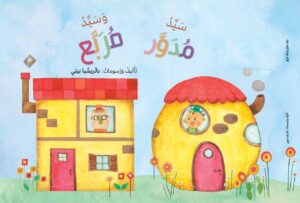 Mr. Round and Mr. Square
Mr. Round and Mr. Square 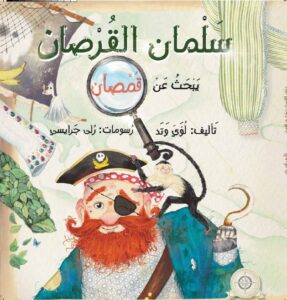 Salman the Pirate Searches for Shirts
Salman the Pirate Searches for Shirts 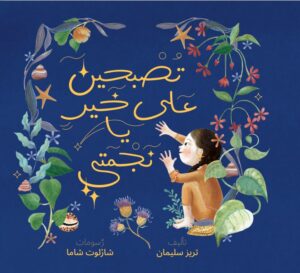 Good Night, My Star
Good Night, My Star 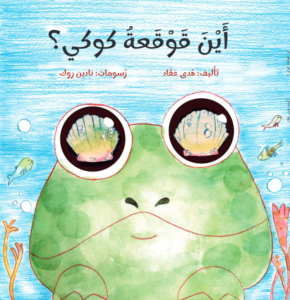 Where is Cookie’s Shell?
Where is Cookie’s Shell? 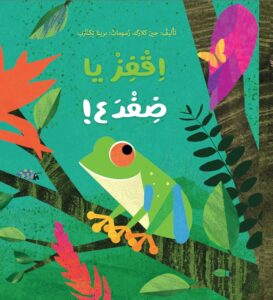 Jump, Little Frog!
Jump, Little Frog! 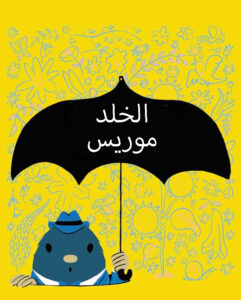 Maurice the Mole
Maurice the Mole 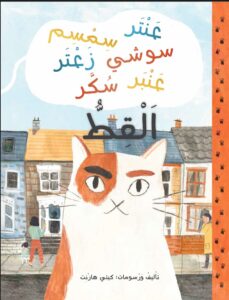 Archie Snuflekins Oliver Valentine Cupcake Tiberius
Archie Snuflekins Oliver Valentine Cupcake Tiberius 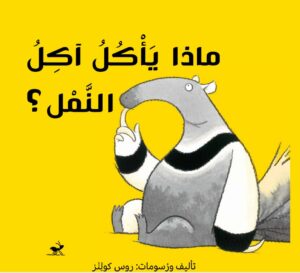 What Does The Anteater Eat?
What Does The Anteater Eat? 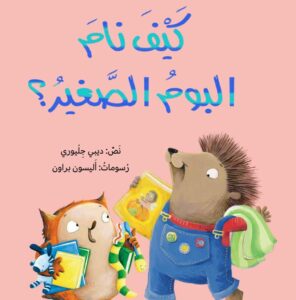 How the Little Owl Slept
How the Little Owl Slept 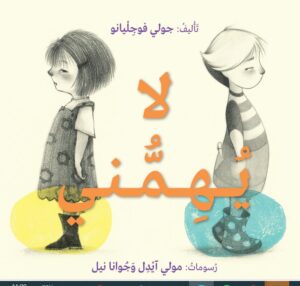 I Don’t Care
I Don’t Care 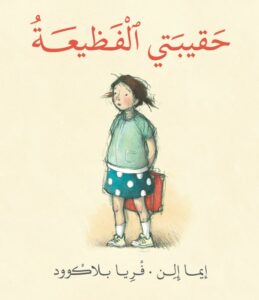 My Terrible Bag
My Terrible Bag 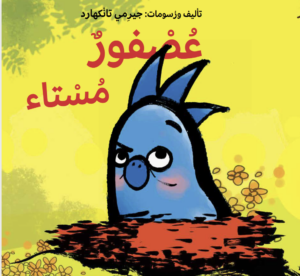 Grumpy Bird
Grumpy Bird 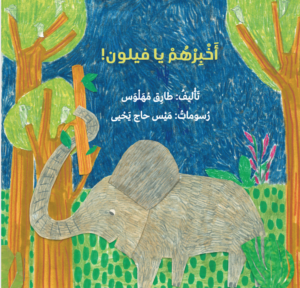 Fayloon
Fayloon 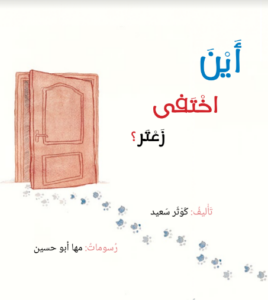 Where did Zaatar Disappear?
Where did Zaatar Disappear? 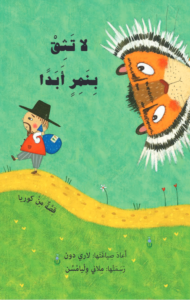 Don’t Trust The Tiger
Don’t Trust The Tiger 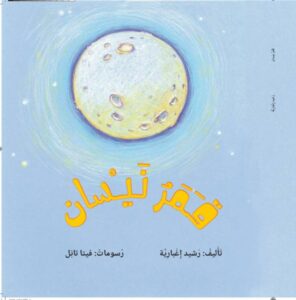 Nisan’s Moon
Nisan’s Moon 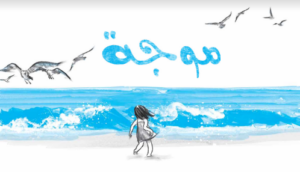 Wave
Wave 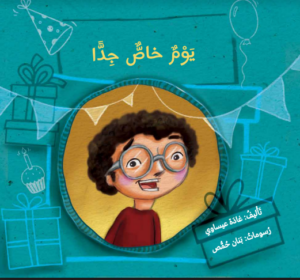 A Very Special Day
A Very Special Day 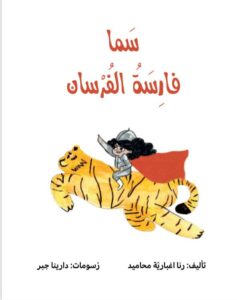 Sama the Chivalrous Knight
Sama the Chivalrous Knight  Where will you take me, Rashid?
Where will you take me, Rashid? 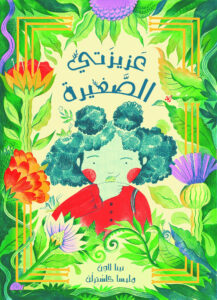 Dear Little One
Dear Little One 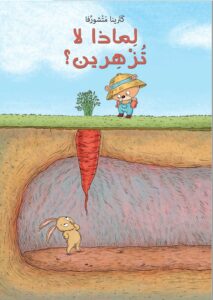 Why Don’t You Bloom?
Why Don’t You Bloom? 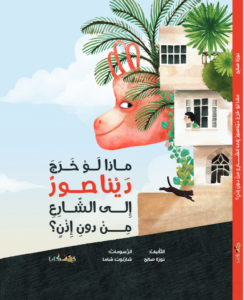 What if the Dinosaur Went Out to the Street
What if the Dinosaur Went Out to the Street 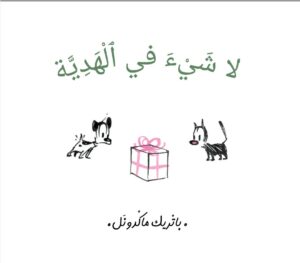 The Gift of Nothing
The Gift of Nothing 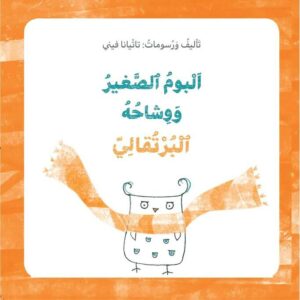 The Small Owl and his Orange Scarf
The Small Owl and his Orange Scarf 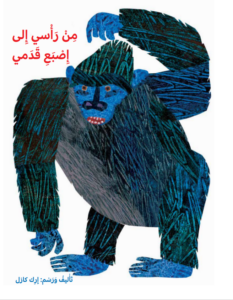 From My Head to My Toe
From My Head to My Toe 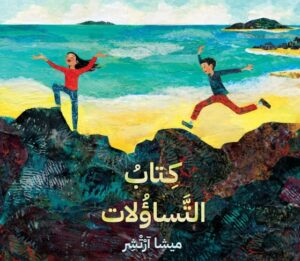 Book of Questions
Book of Questions 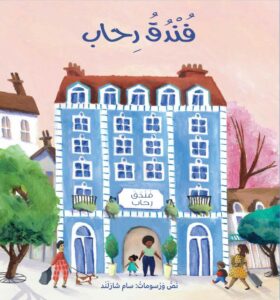 Rihab’s Hotel
Rihab’s Hotel 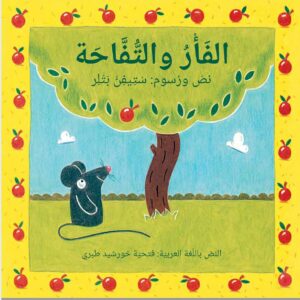 The Mouse and the Apple
The Mouse and the Apple  When Water Flooded the City
When Water Flooded the City 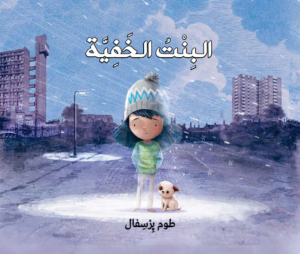 The Invisible
The Invisible 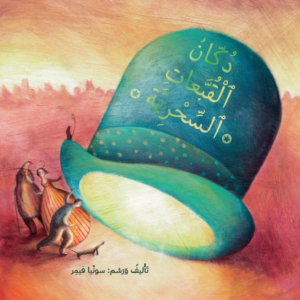 The magic hat shop
The magic hat shop 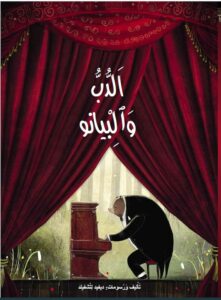 The Bear and the piano
The Bear and the piano  The book tree
The book tree 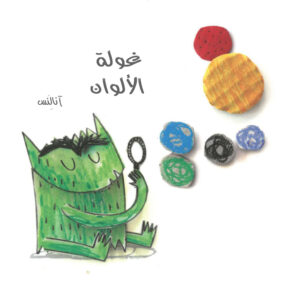 The Color Monster
The Color Monster 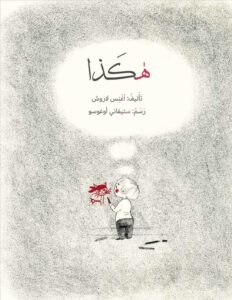 Because
Because 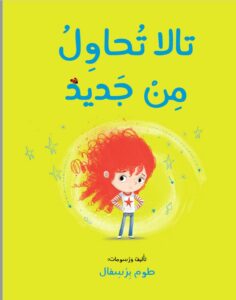 Tilda tries again
Tilda tries again 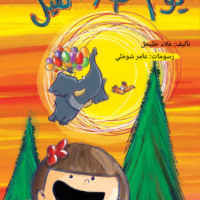 The Day the Elephant Flew
The Day the Elephant Flew 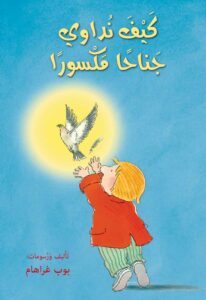 How to heal a broken wing
How to heal a broken wing 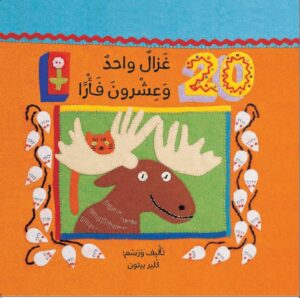 One Moose, Twenty Mice
One Moose, Twenty Mice 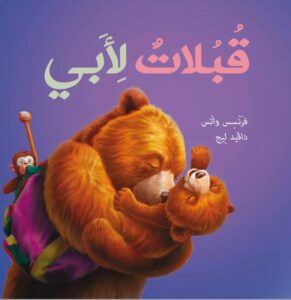 Kisses for Daddy
Kisses for Daddy 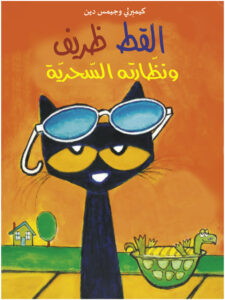 Pete the cat & his magic sunglasses
Pete the cat & his magic sunglasses 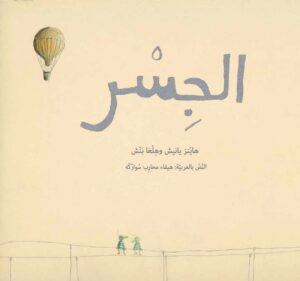 The Bridge
The Bridge 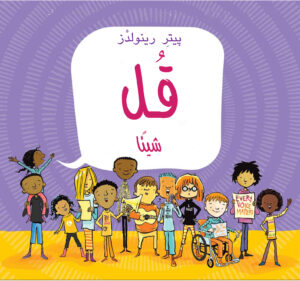 Say something
Say something 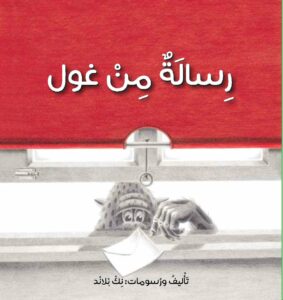 A Monster wrote me a Letter
A Monster wrote me a Letter 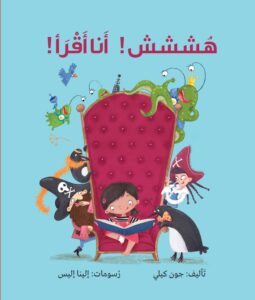 Shhh! I’m reading
Shhh! I’m reading 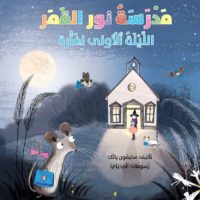 Mouse’s First Night at Moonlight School
Mouse’s First Night at Moonlight School 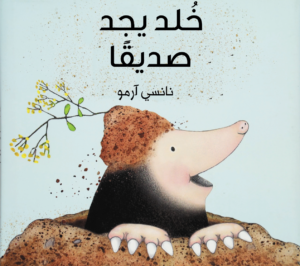 A Friend for Mole
A Friend for Mole 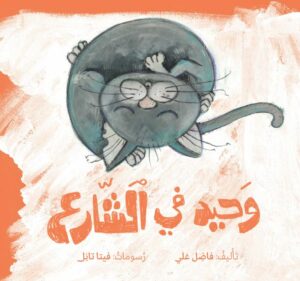 Wahid in the Street
Wahid in the Street 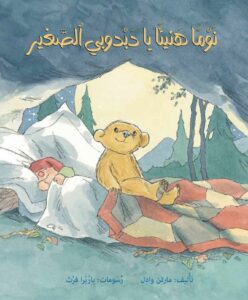 Sleep Tight Little Bear
Sleep Tight Little Bear 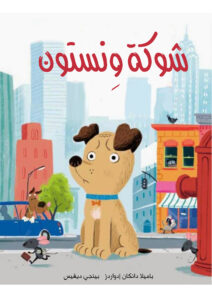 Winston was Worried
Winston was Worried 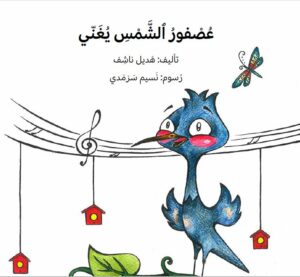 The Sunbird Sings
The Sunbird Sings 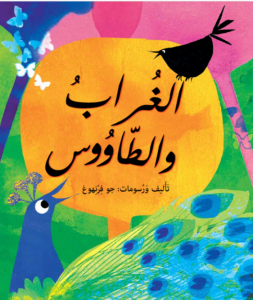 The Crow and the Peacock
The Crow and the Peacock 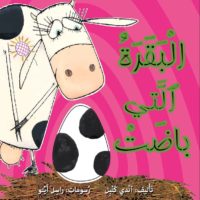 The Cow That Laid an Egg
The Cow That Laid an Egg 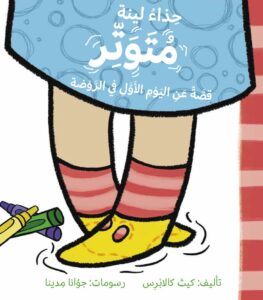 Lena’s Shoes Are Nervous
Lena’s Shoes Are Nervous 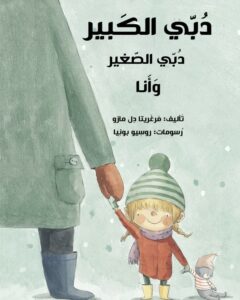 My big bear, my little bear and me
My big bear, my little bear and me 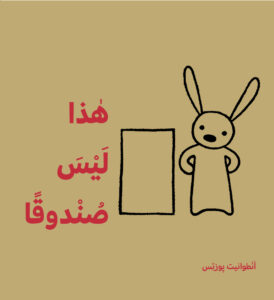 Not a Box
Not a Box 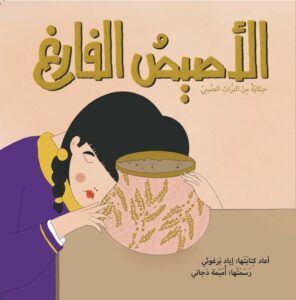 The Empty Pot
The Empty Pot 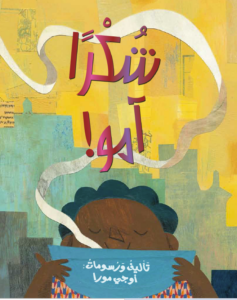 Thank You Omu
Thank You Omu 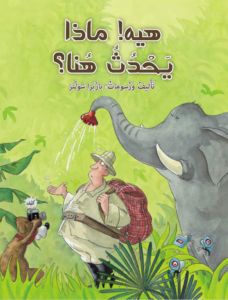 Hey, What’s Happening Here?
Hey, What’s Happening Here?  Tiny perfect things
Tiny perfect things 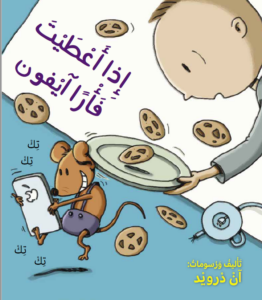 If You Give a Mouse an iPhone
If You Give a Mouse an iPhone 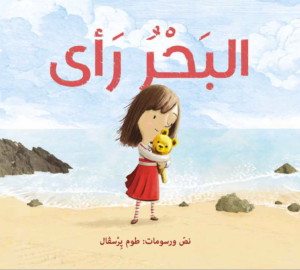 The Sea Saw
The Sea Saw 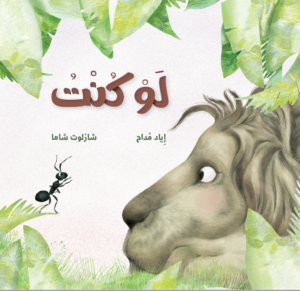 If I Were
If I Were 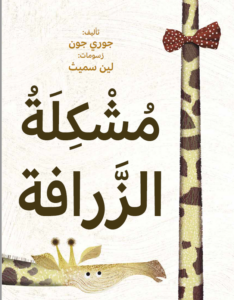 Giraffe Problems
Giraffe Problems 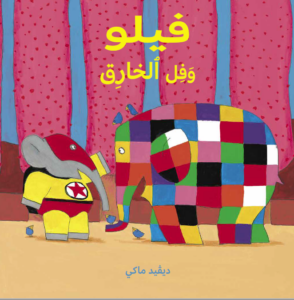 Filo and Super Phil
Filo and Super Phil 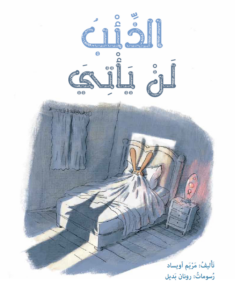 The Wolf Will Not Come
The Wolf Will Not Come 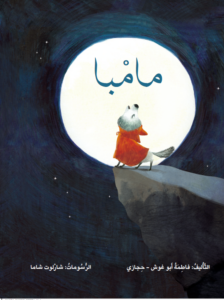 Mamba
Mamba  Mom, What Does this Do?
Mom, What Does this Do?  Beauty of the World
Beauty of the World 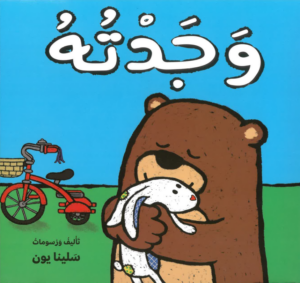 Found
Found 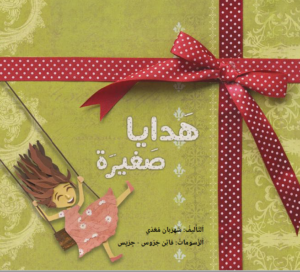 Small Presents
Small Presents 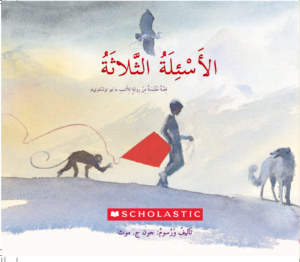 The Three Questions
The Three Questions 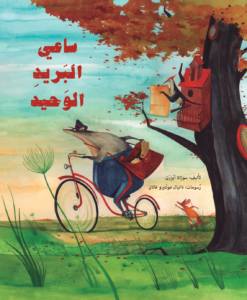 The Lonely Mailman
The Lonely Mailman 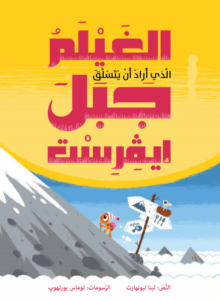 The Turtle Who Wanted to Climb Mount Everest
The Turtle Who Wanted to Climb Mount Everest 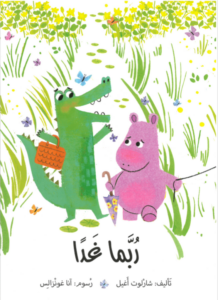 Maybe Tomorrow
Maybe Tomorrow 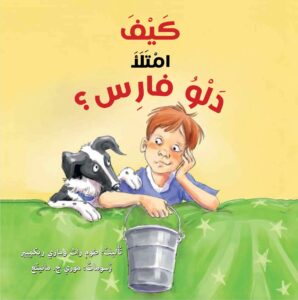 How Full is Your Bucket?
How Full is Your Bucket? 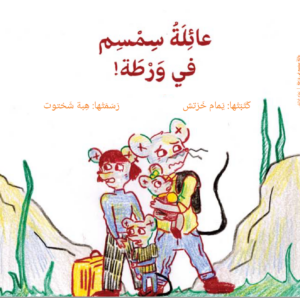 Simsim Family in Trouble
Simsim Family in Trouble 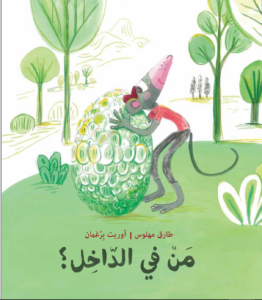 Who’s Inside?
Who’s Inside? 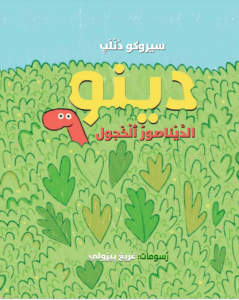 Crunch the Shy Dinosaur
Crunch the Shy Dinosaur 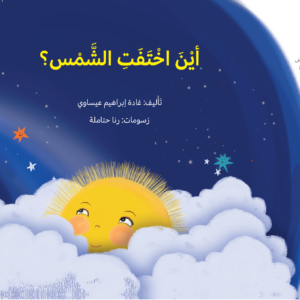 Where Did the Sun Go?
Where Did the Sun Go? 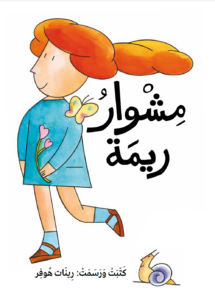 Rima’s walk
Rima’s walk 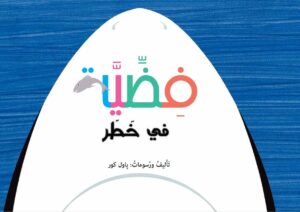 Caspion, Beware!
Caspion, Beware! 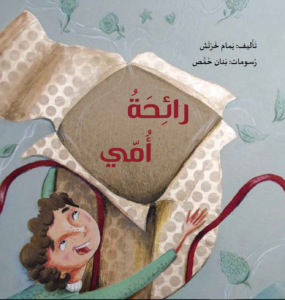 Scent of My Mother
Scent of My Mother 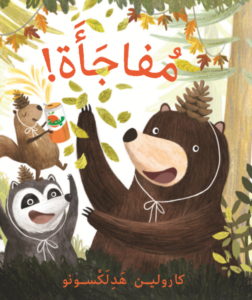 Surprise!
Surprise! 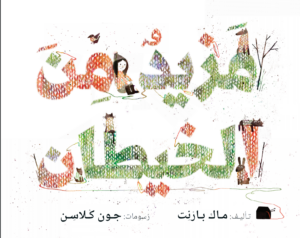 Extra Yarn
Extra Yarn 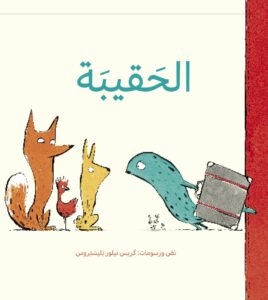 The Suitcase
The Suitcase 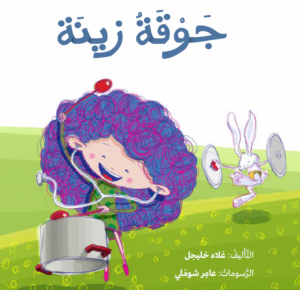 Zena’s Band
Zena’s Band  Strictly No Elephants
Strictly No Elephants  The girl who never made mistakes
The girl who never made mistakes 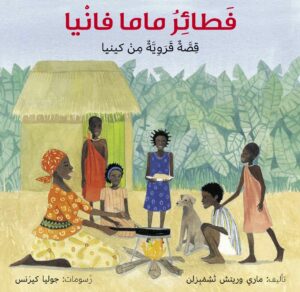 Mama Panya’s Pancakes
Mama Panya’s Pancakes 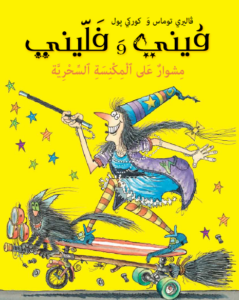 Winnie and Wilber: The Broomstick Ride
Winnie and Wilber: The Broomstick Ride  Emanual’s Dream
Emanual’s Dream 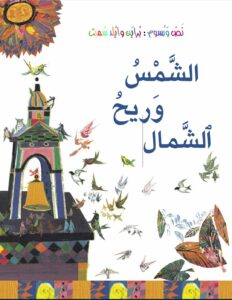 The North Wind and the Sun
The North Wind and the Sun 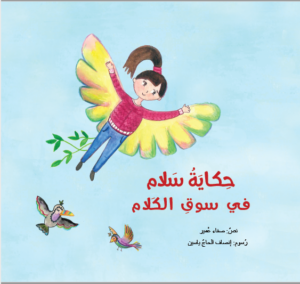 The Market of Words
The Market of Words 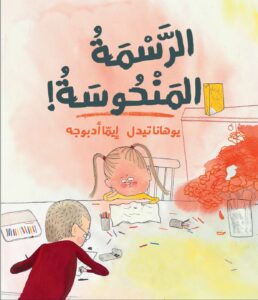 The misfortune drawing
The misfortune drawing 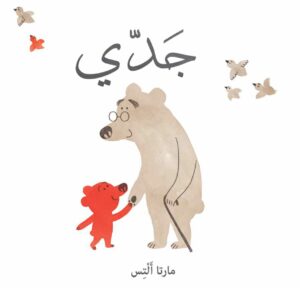 My Grandpa
My Grandpa 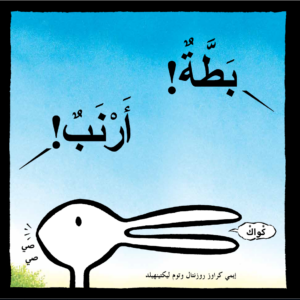 Duck! Rabbit!
Duck! Rabbit! 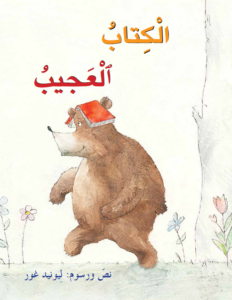 The wonderful book
The wonderful book  Hiding Heidi
Hiding Heidi 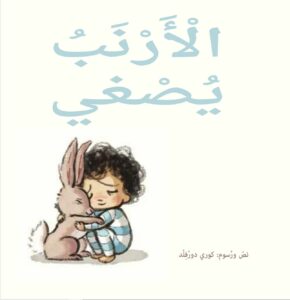 The Rabbit Listened
The Rabbit Listened 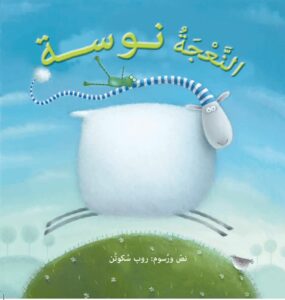 Russel The Sheep
Russel The Sheep 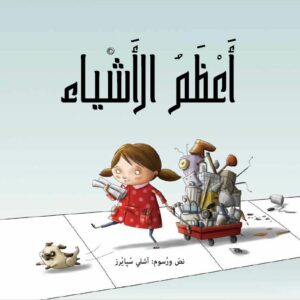 The Most Magnificent Thing
The Most Magnificent Thing 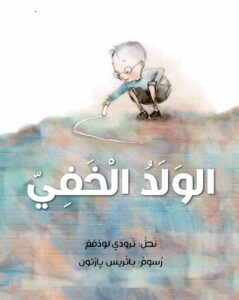 The Invisible Boy
The Invisible Boy 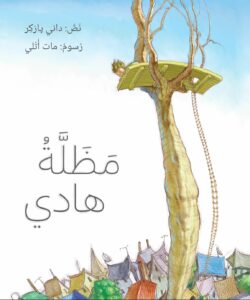 Parachute
Parachute 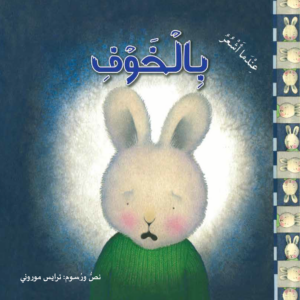 When I’m feeling scared
When I’m feeling scared 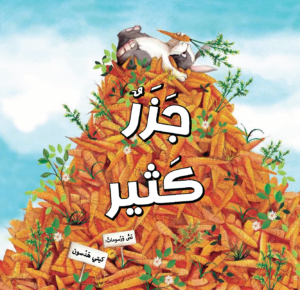 Too many carrots
Too many carrots 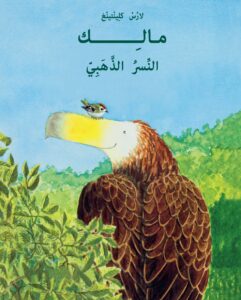 Malek, the Golden Eagle
Malek, the Golden Eagle  The Wild Baby Goes to Sea
The Wild Baby Goes to Sea 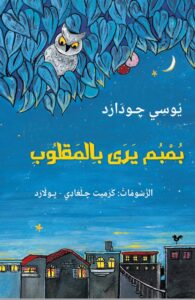 The Backward Owl
The Backward Owl 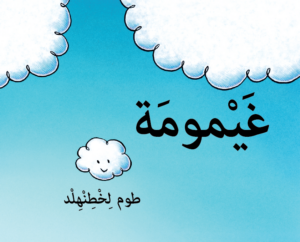 Cloudette
Cloudette 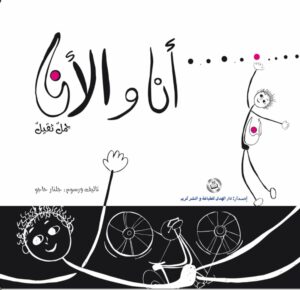 It’s Not Easy to Be Me
It’s Not Easy to Be Me 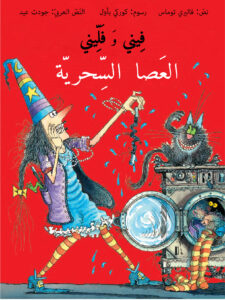 Winnie and Wilbur: The Magic Wand
Winnie and Wilbur: The Magic Wand 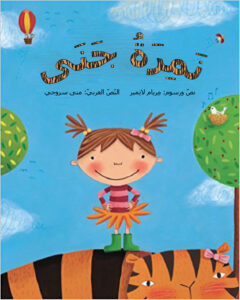 Emily’s Tiger
Emily’s Tiger 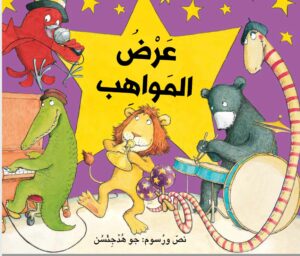 The Talent Show
The Talent Show 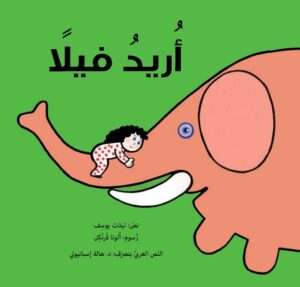 I Want an Elephant
I Want an Elephant 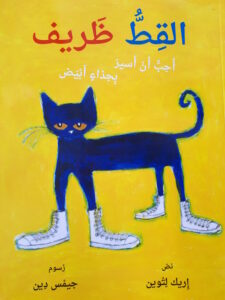 Pete the Cat- I Love My White Shoe
Pete the Cat- I Love My White Shoe 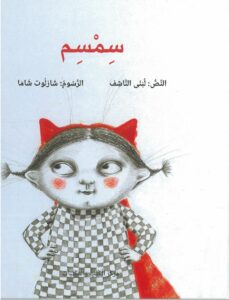 Simsim
Simsim 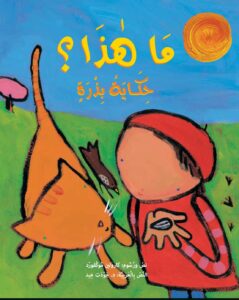 What’s This?
What’s This?  How Much I Laugh!
How Much I Laugh!  Oh Dear Geoffrey!
Oh Dear Geoffrey! 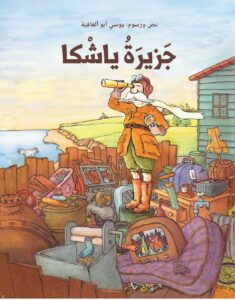 Yashka’s Island
Yashka’s Island 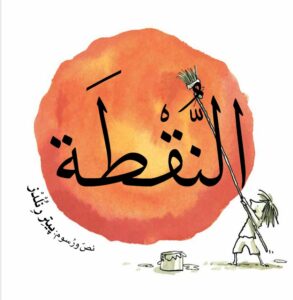 The Dot
The Dot 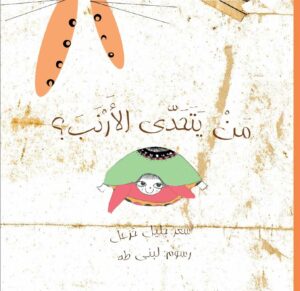 Who Challenges the Rabbit?
Who Challenges the Rabbit?  Saad and His New Cap
Saad and His New Cap 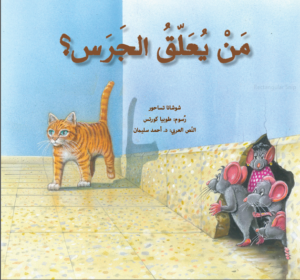 Who Will Hang the Bell
Who Will Hang the Bell 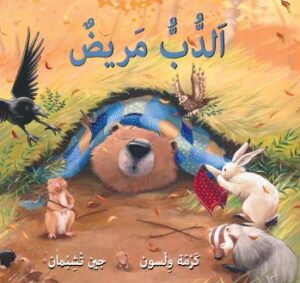 Bear Feels Sick
Bear Feels Sick 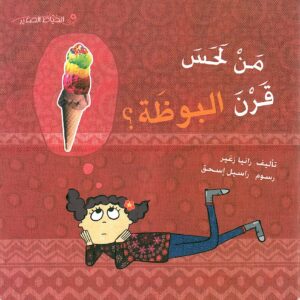 Who Licked the Ice Cream Cone?
Who Licked the Ice Cream Cone? 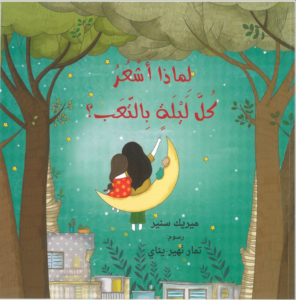 Why Am I Tired At Night?
Why Am I Tired At Night? 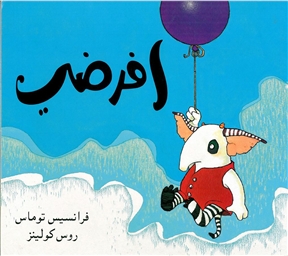 Supposing
Supposing  Augustus and His Smile
Augustus and His Smile 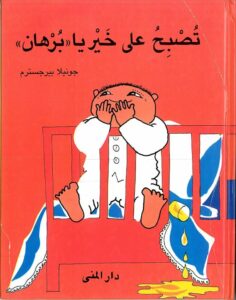 Good Night Burhan
Good Night Burhan  The Little Pickpocket
The Little Pickpocket  Sisi’s Clothespins
Sisi’s Clothespins 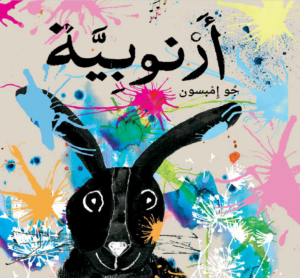 Rabbityness
Rabbityness 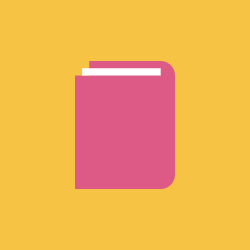 The Goat and Its Little Ones
The Goat and Its Little Ones 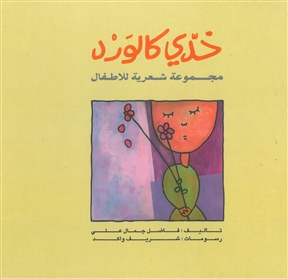 My Cheek is Like A Rose
My Cheek is Like A Rose 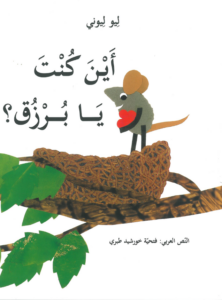 Nicolas Where Have You Been?
Nicolas Where Have You Been? 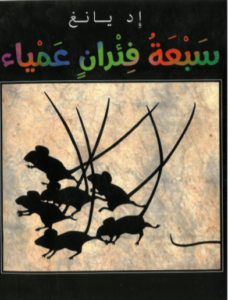 Seven Blind Mice
Seven Blind Mice 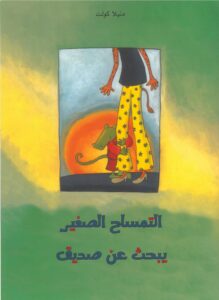 The Alligator Looks For a New Friend
The Alligator Looks For a New Friend 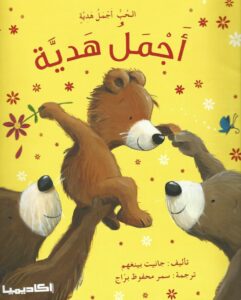 The Best Present
The Best Present  Duna Wants
Duna Wants 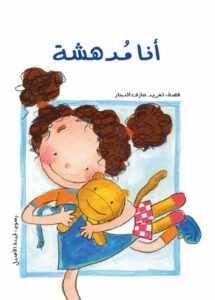 I’m Amazing
I’m Amazing 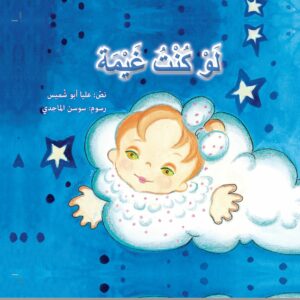 If I Were A Cloud
If I Were A Cloud 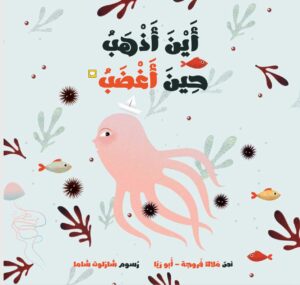 Where Do I Go When I’m Angry
Where Do I Go When I’m Angry  I Forgot My Wings At Home
I Forgot My Wings At Home  Will (Sa’ad) Gets a Haircut
Will (Sa’ad) Gets a Haircut  I Want to Dance
I Want to Dance  Good Night Little Ones
Good Night Little Ones  Three Butterflies
Three Butterflies  Mummy and Me
Mummy and Me 
